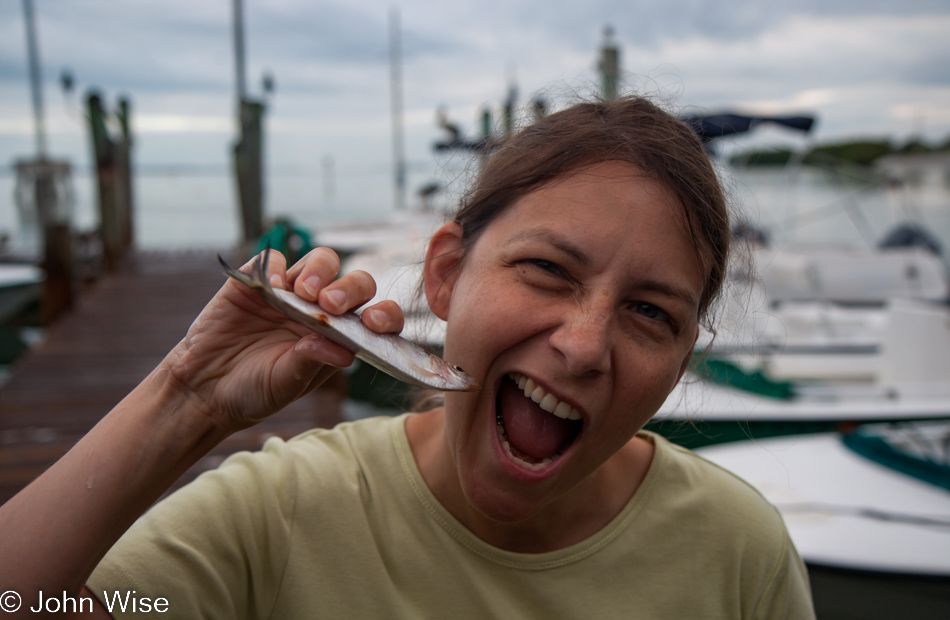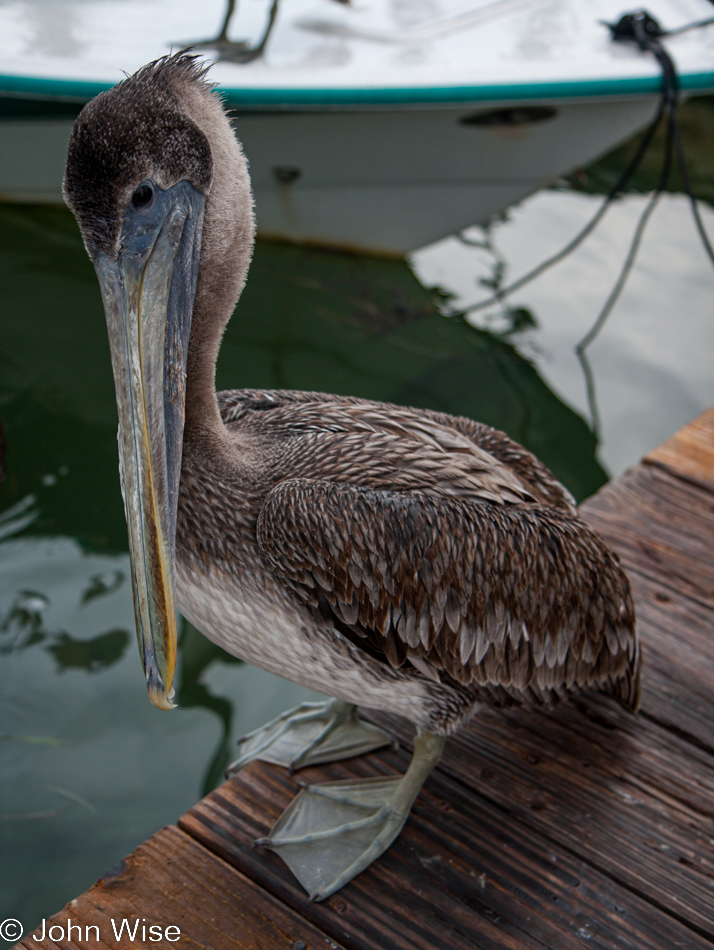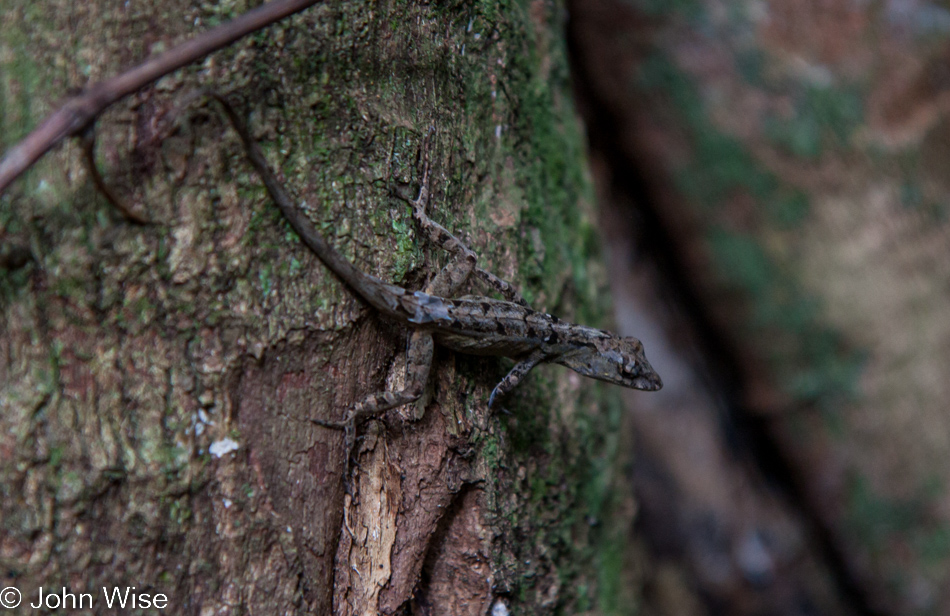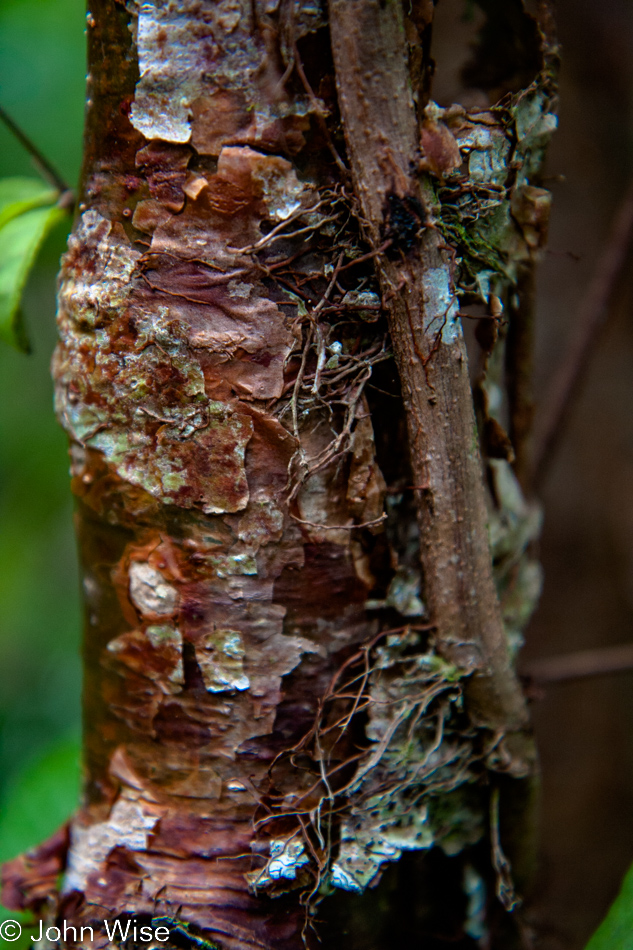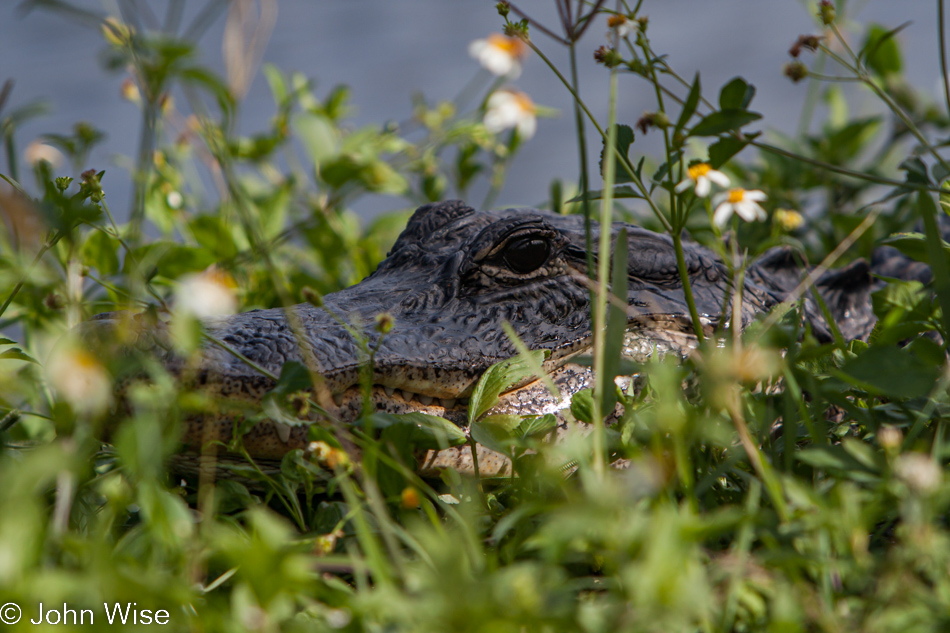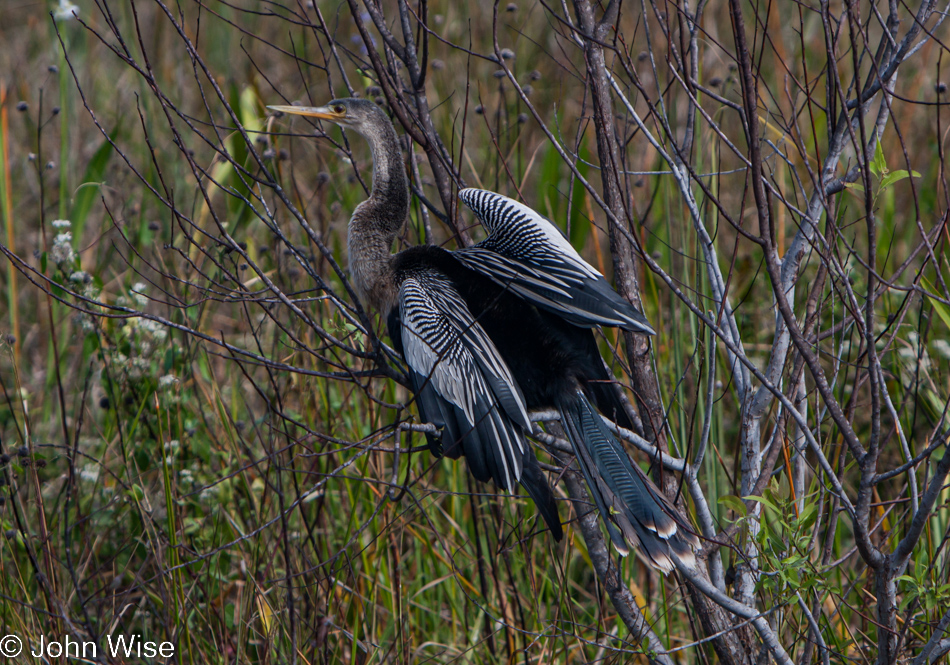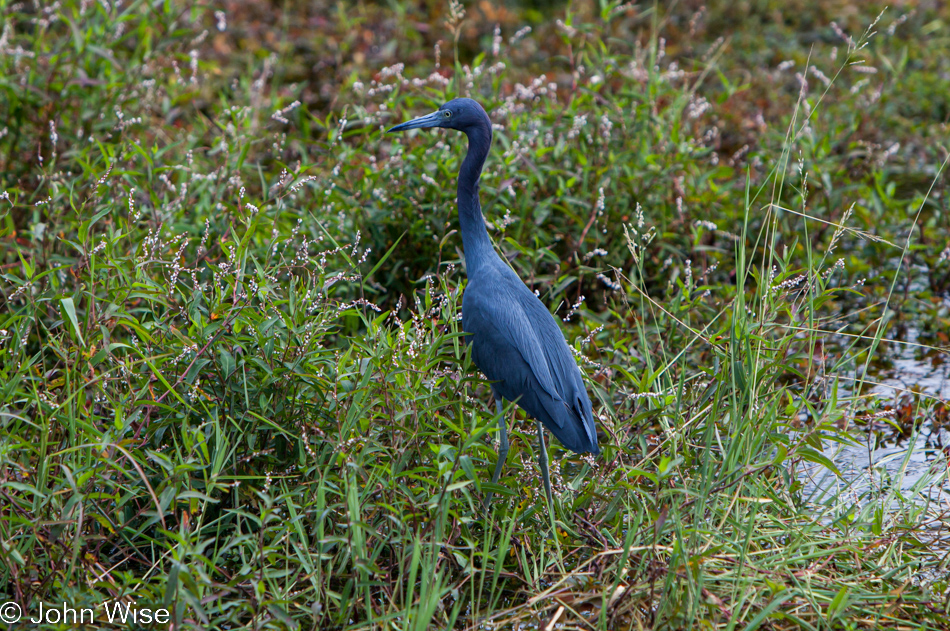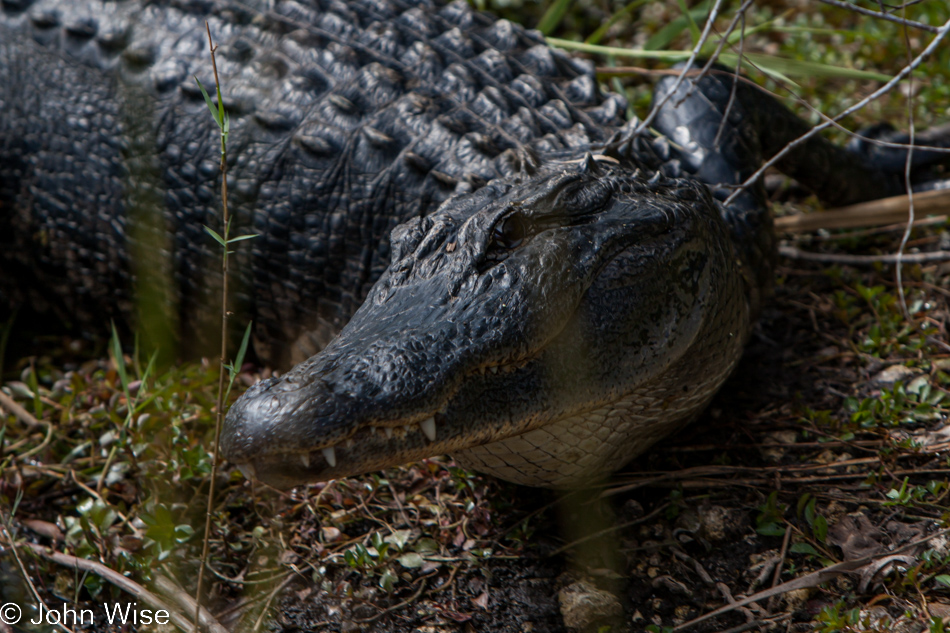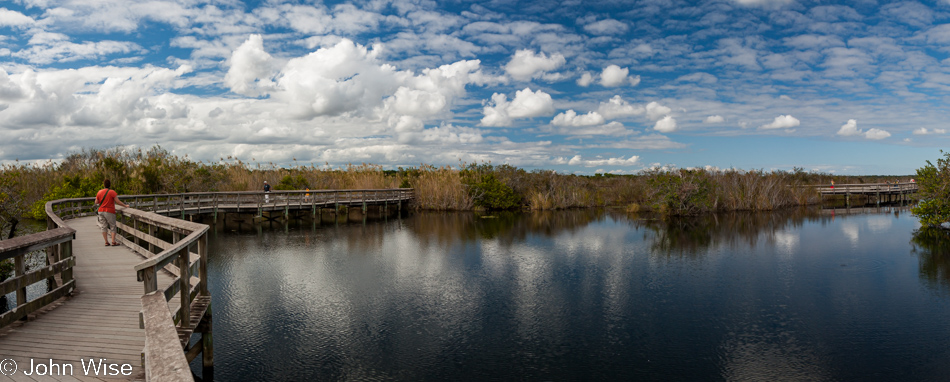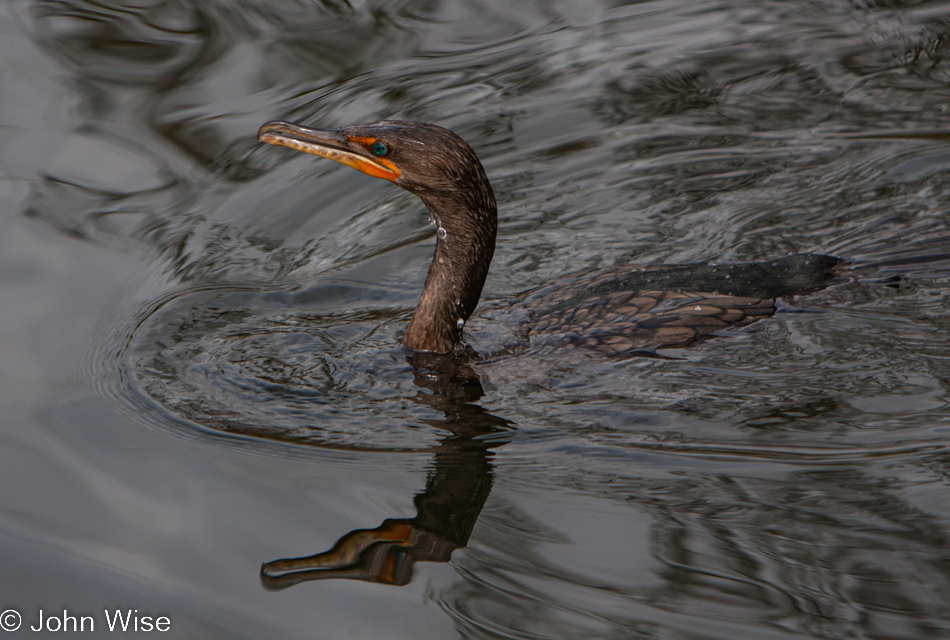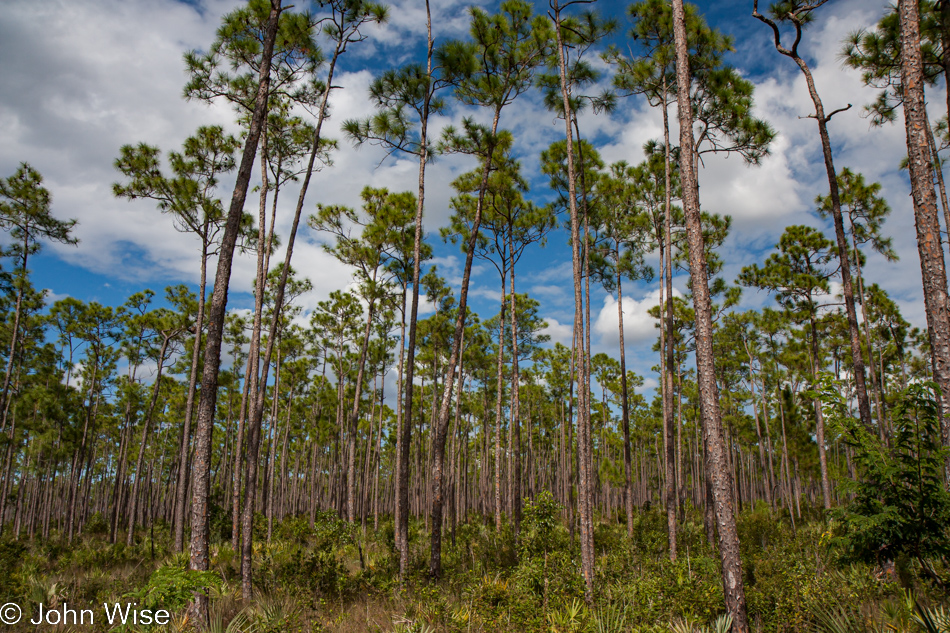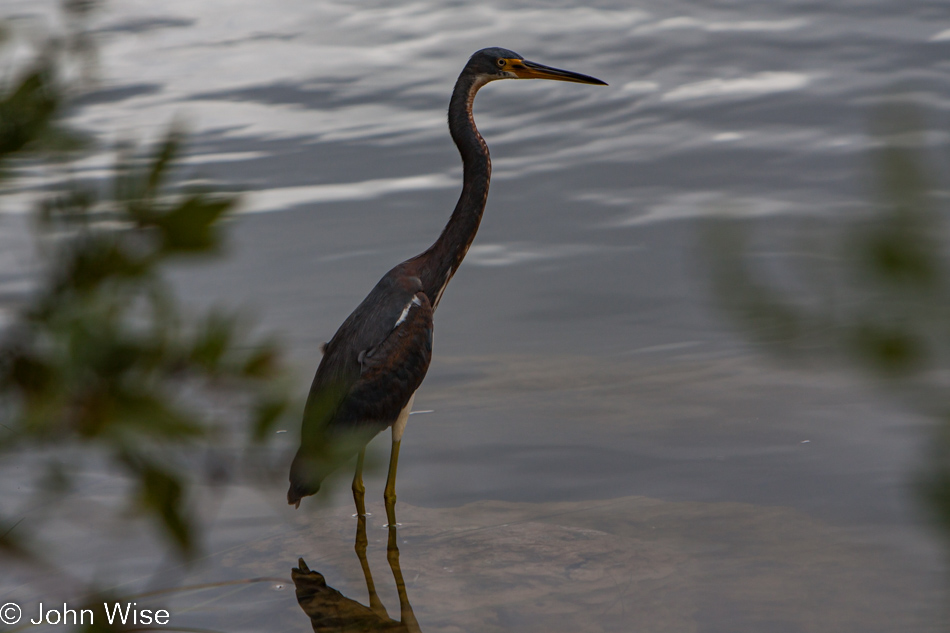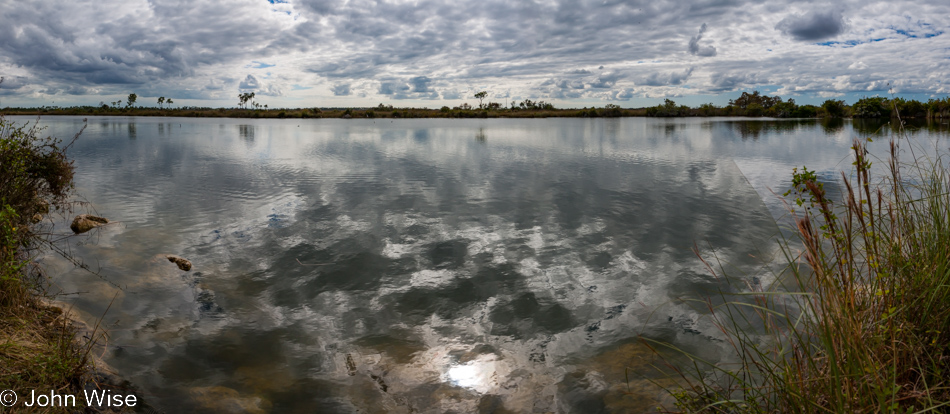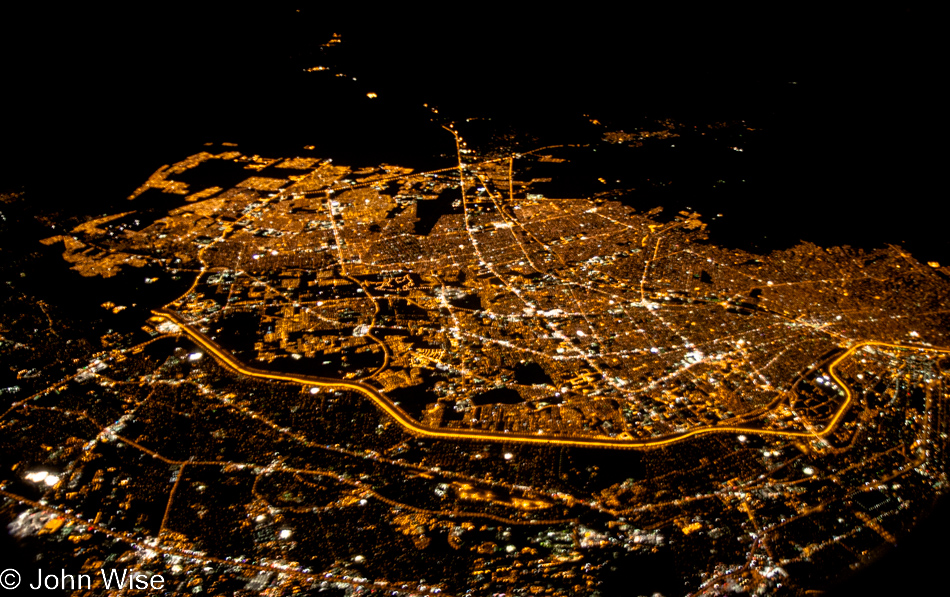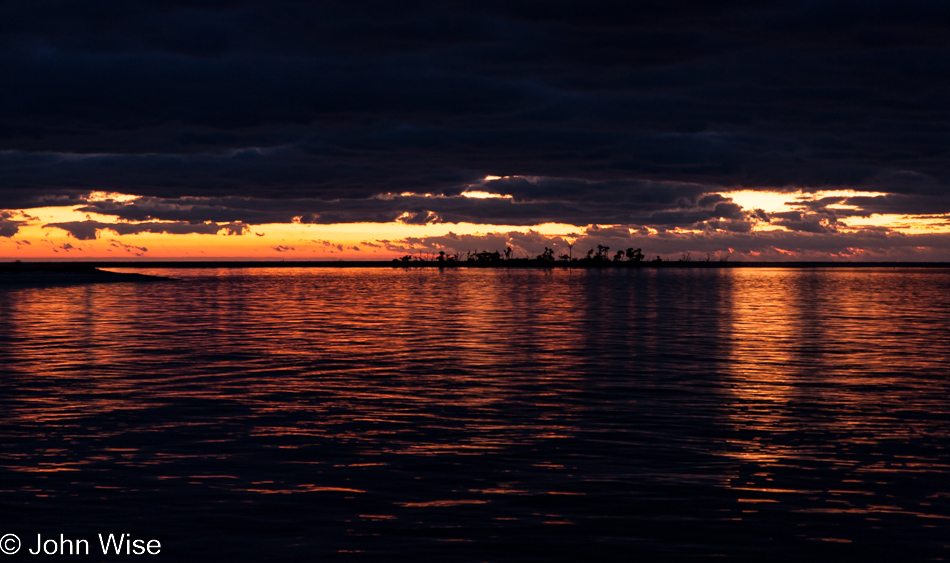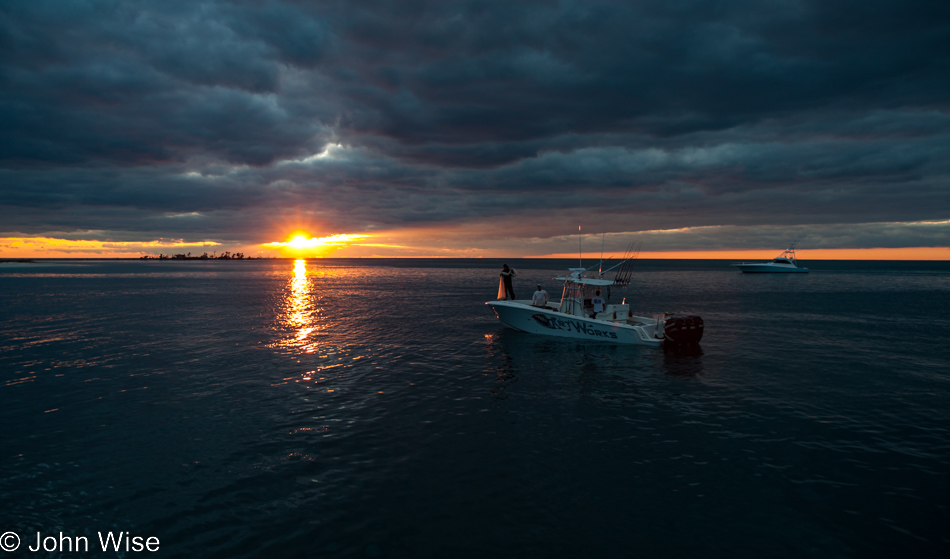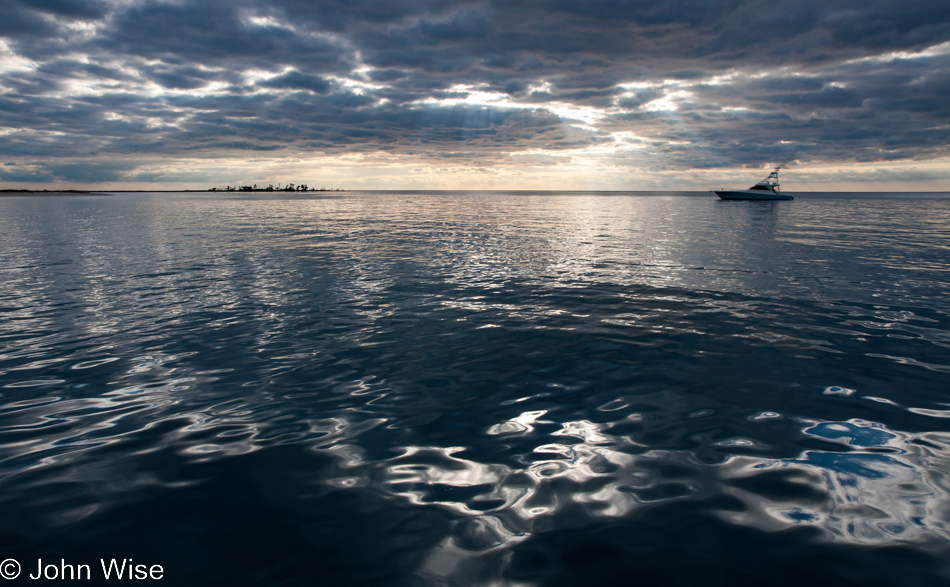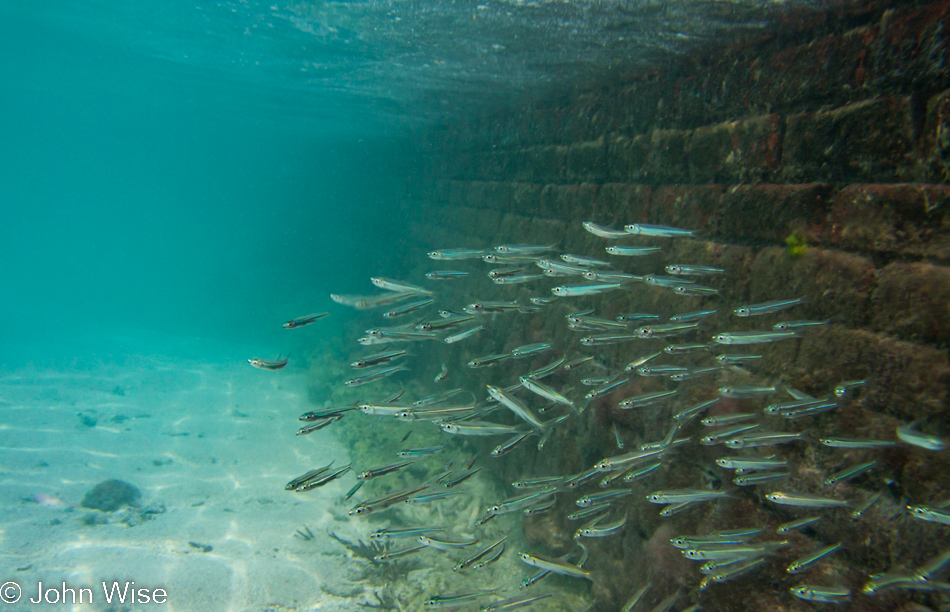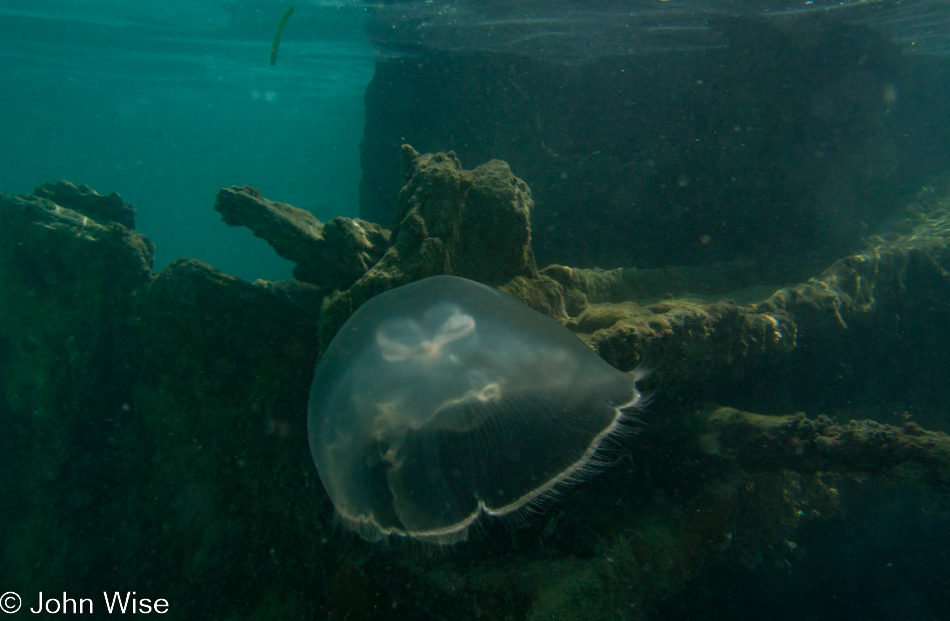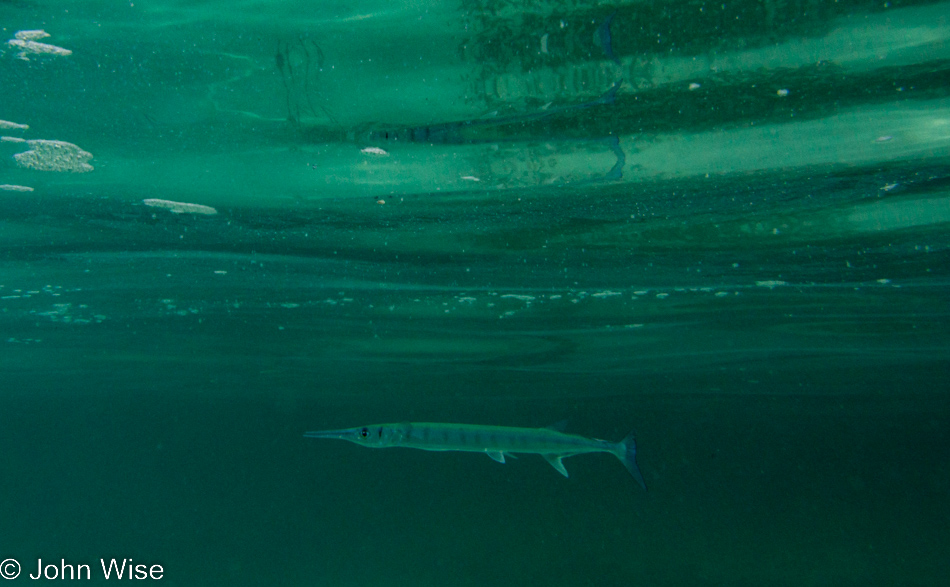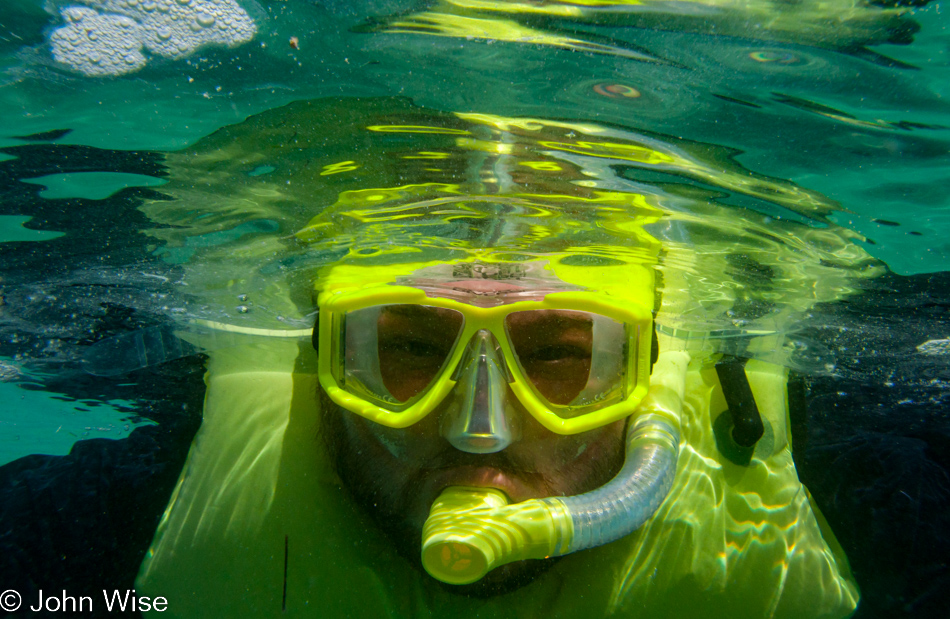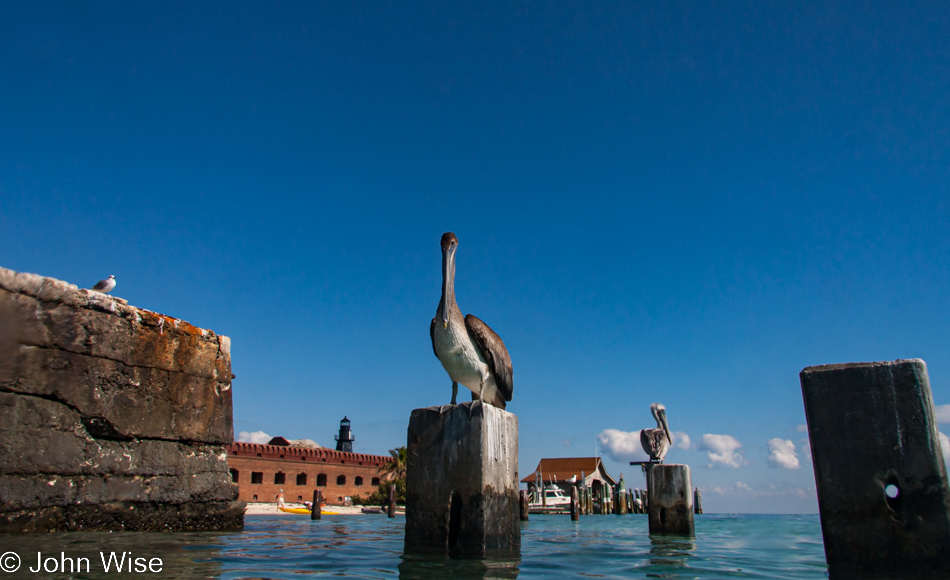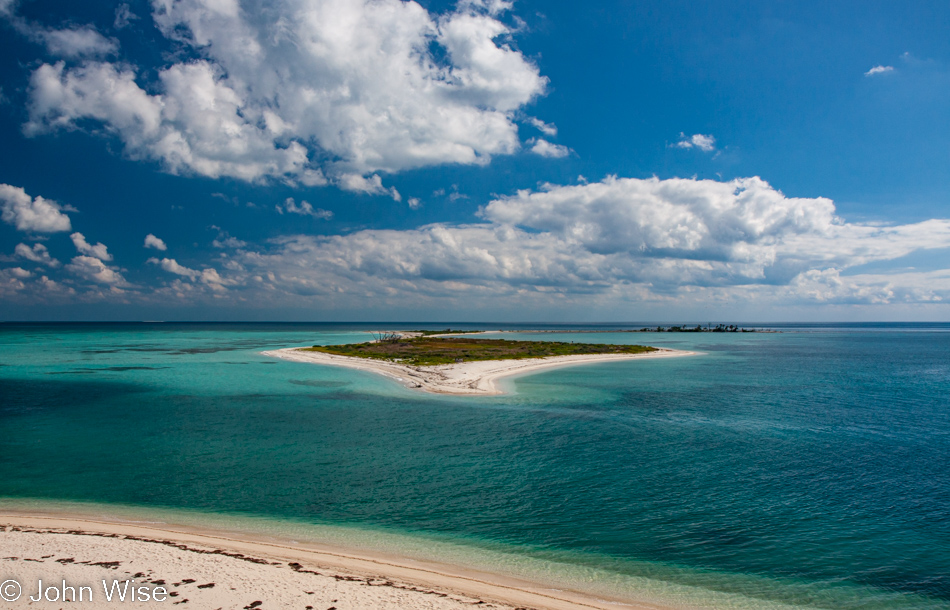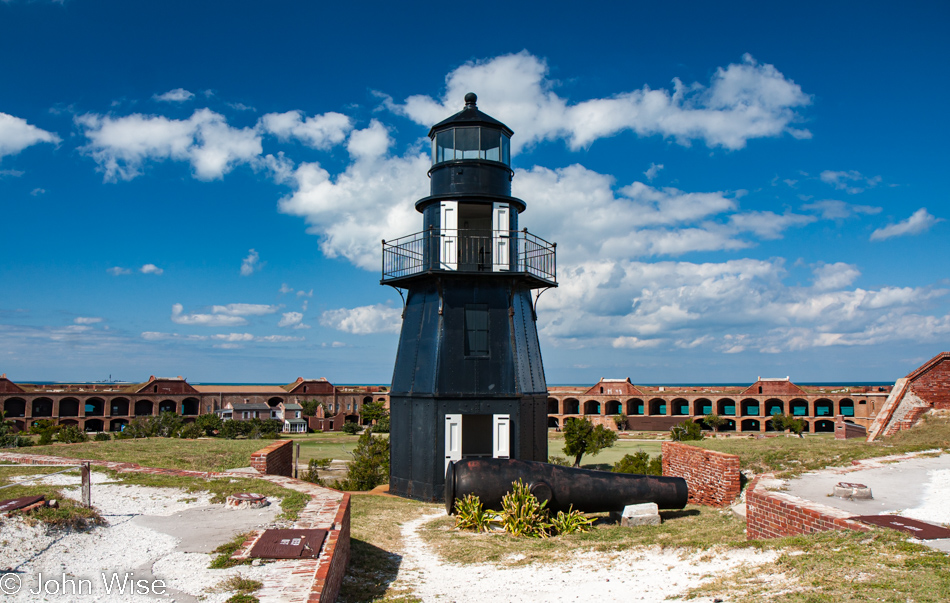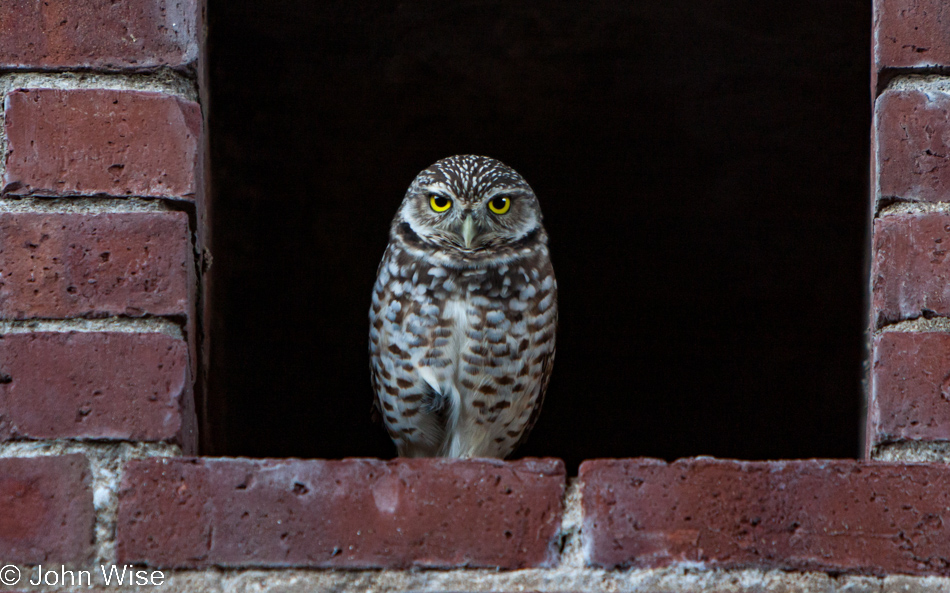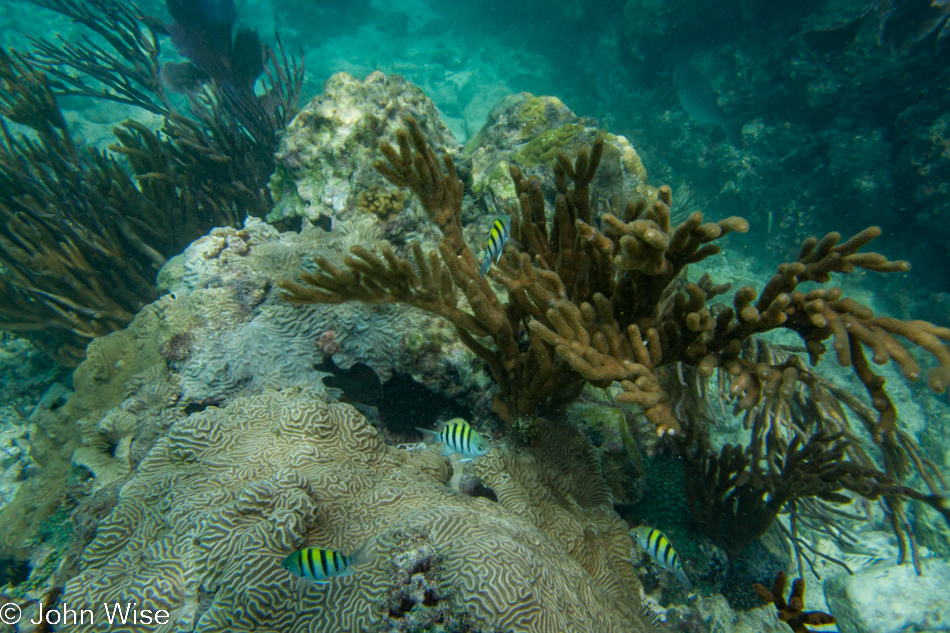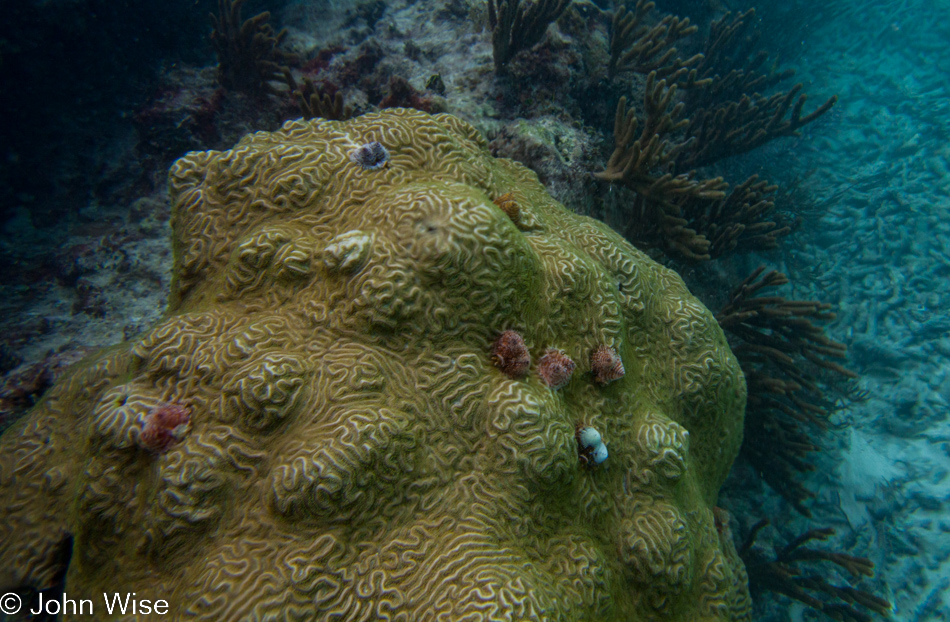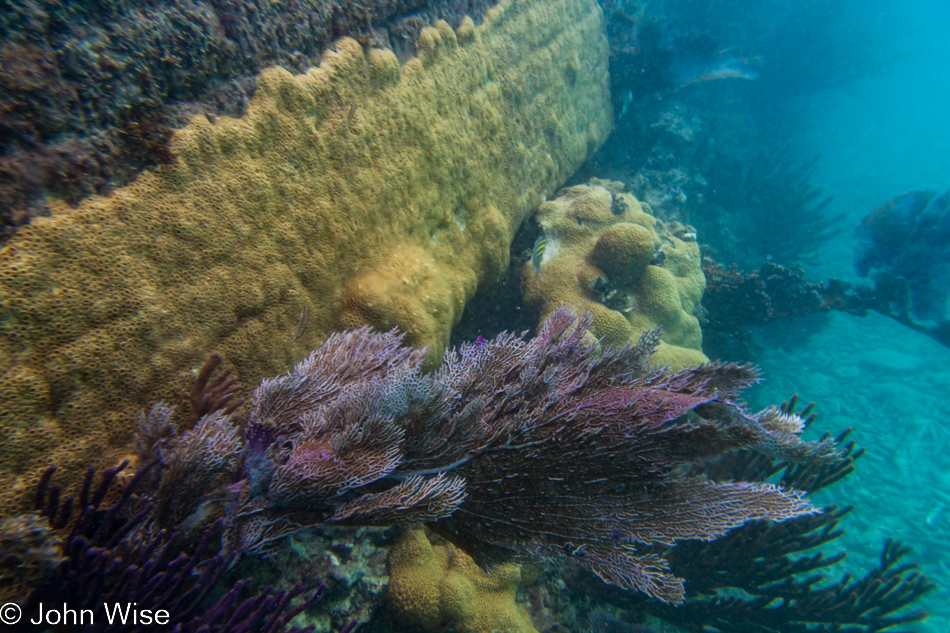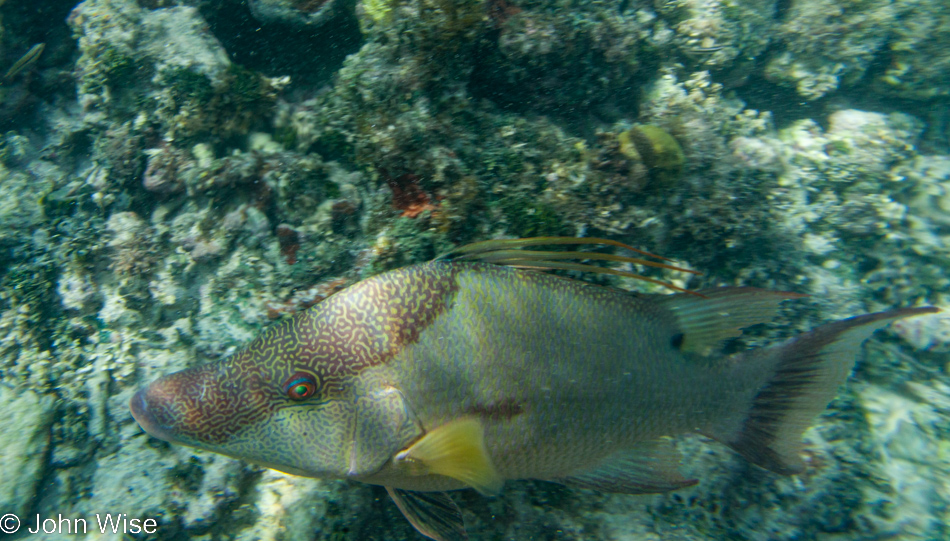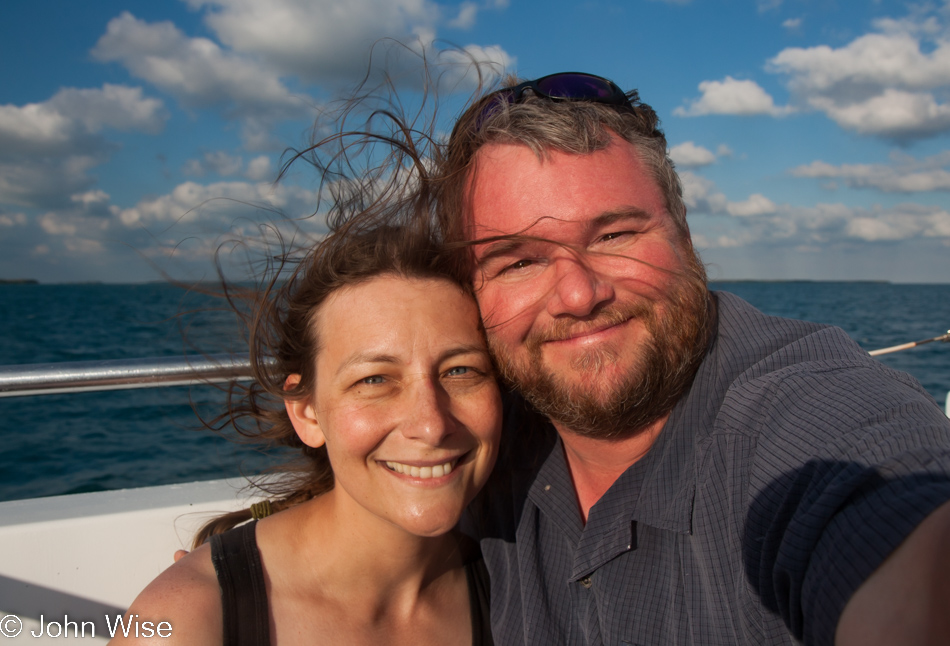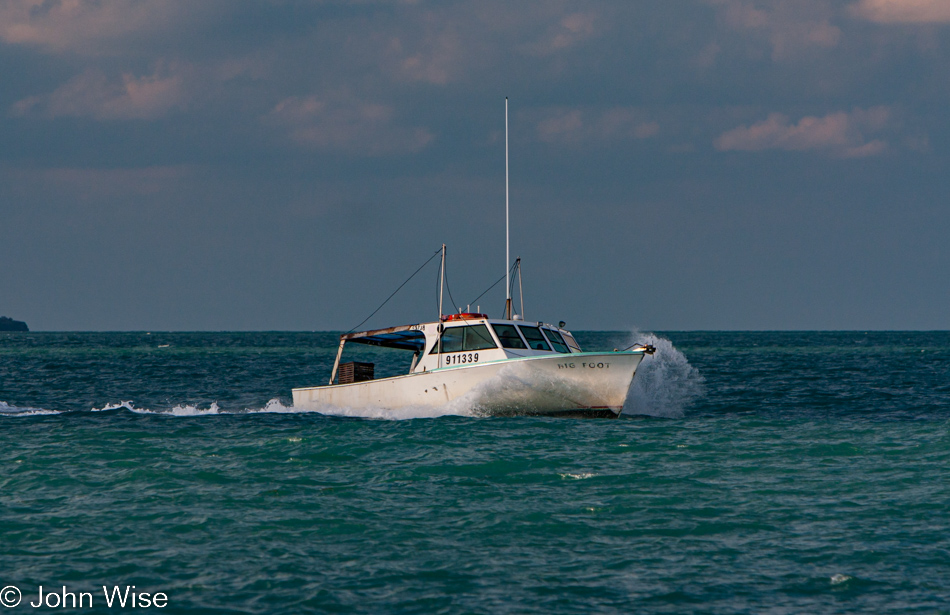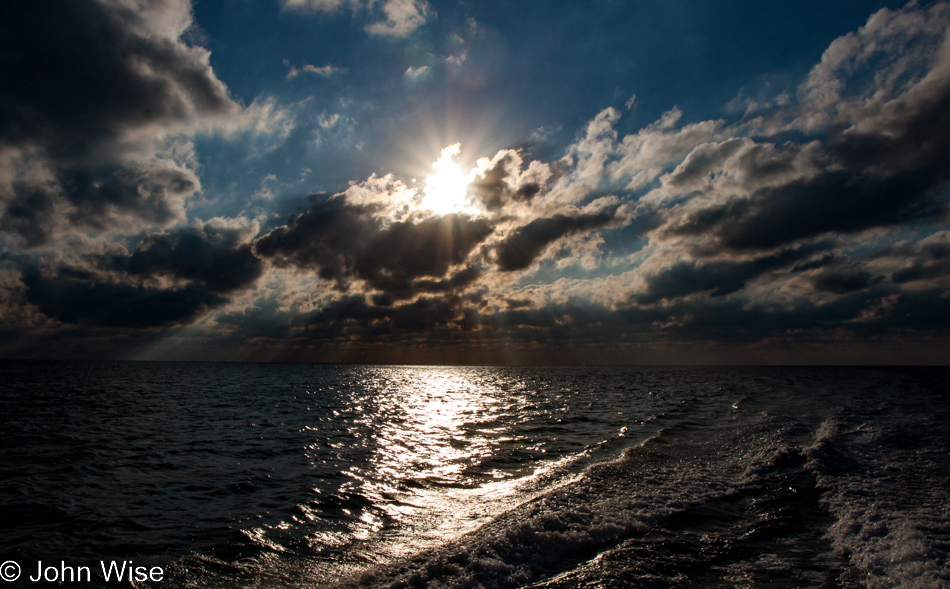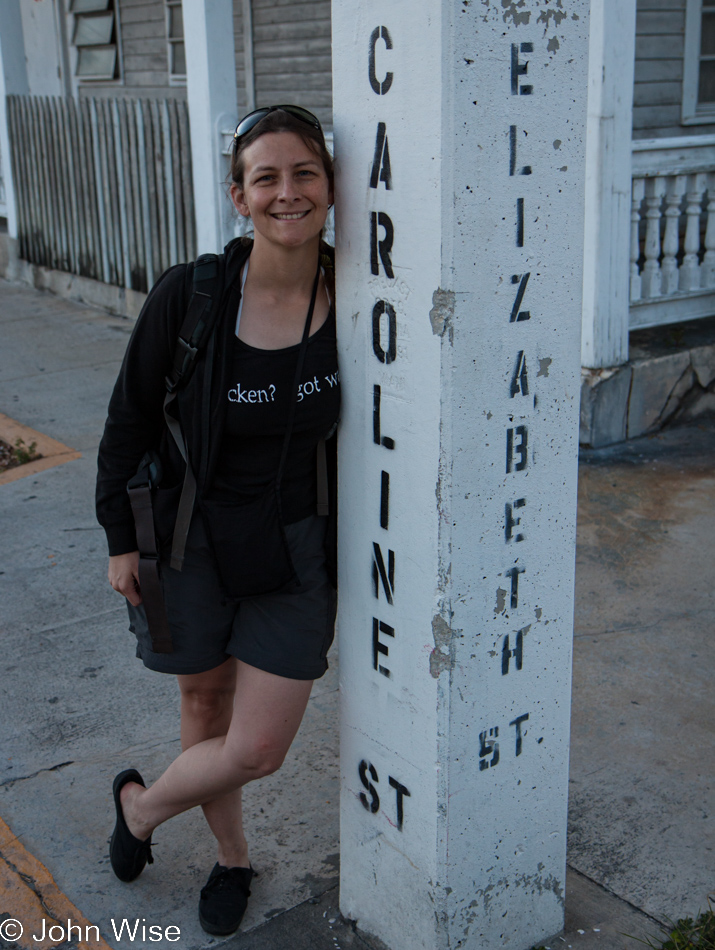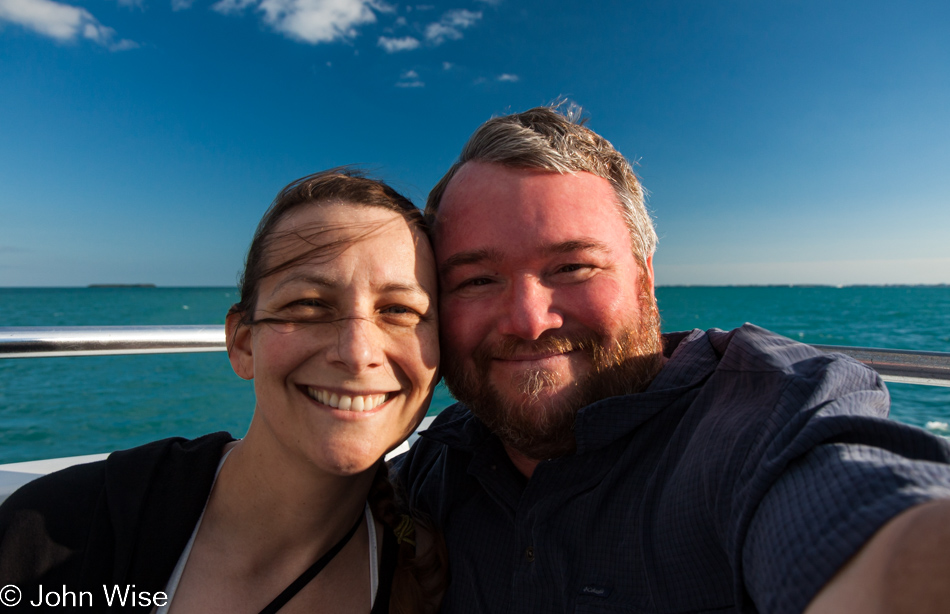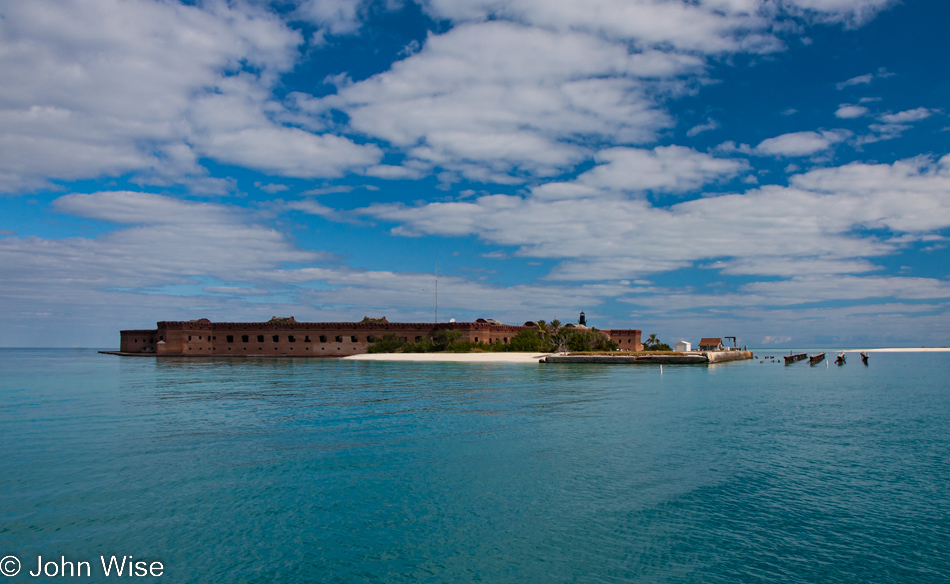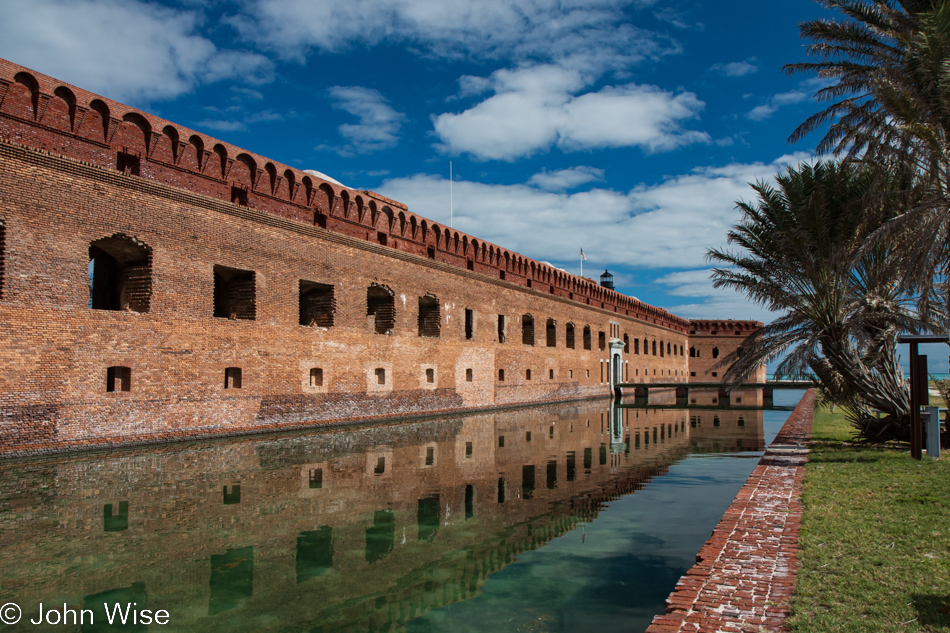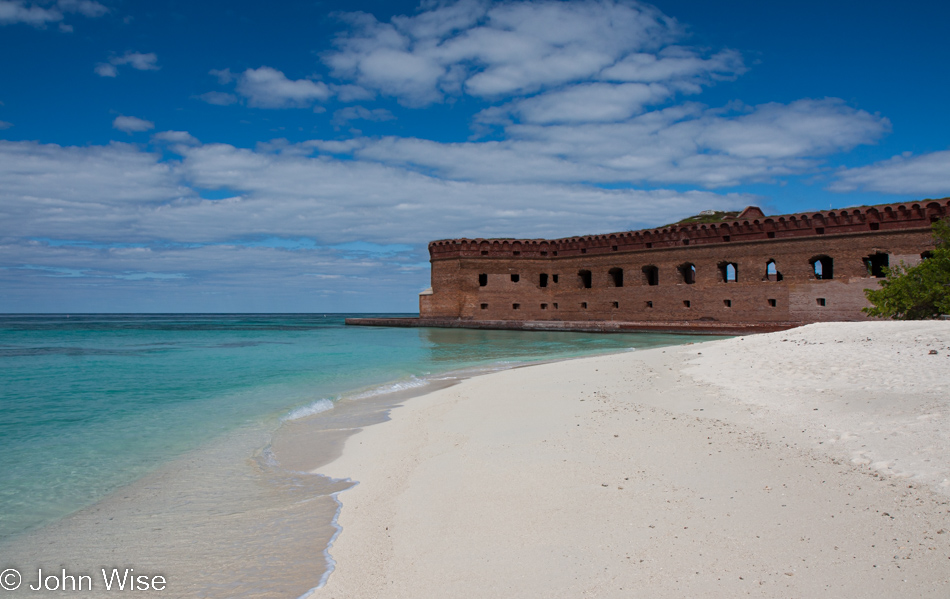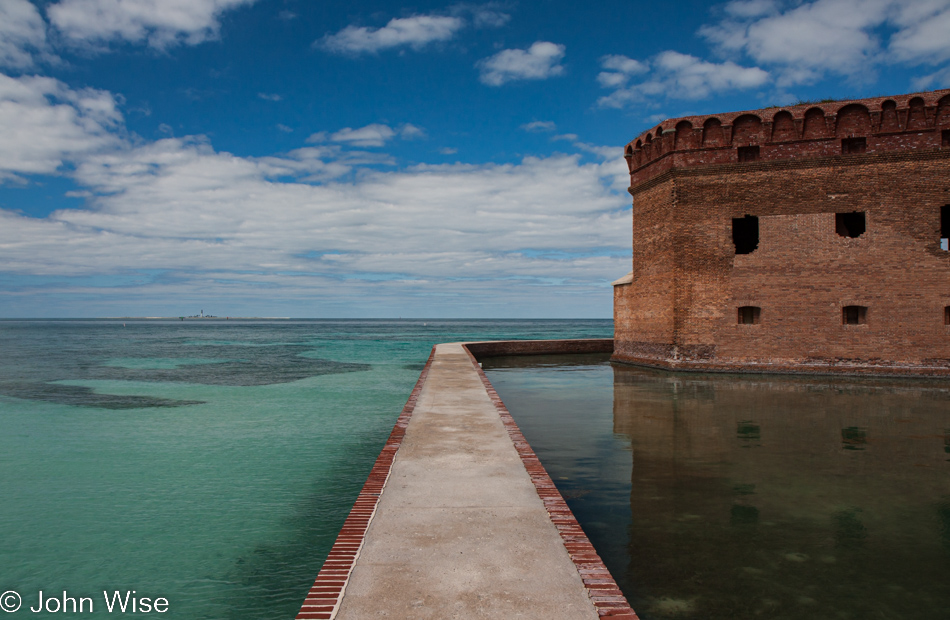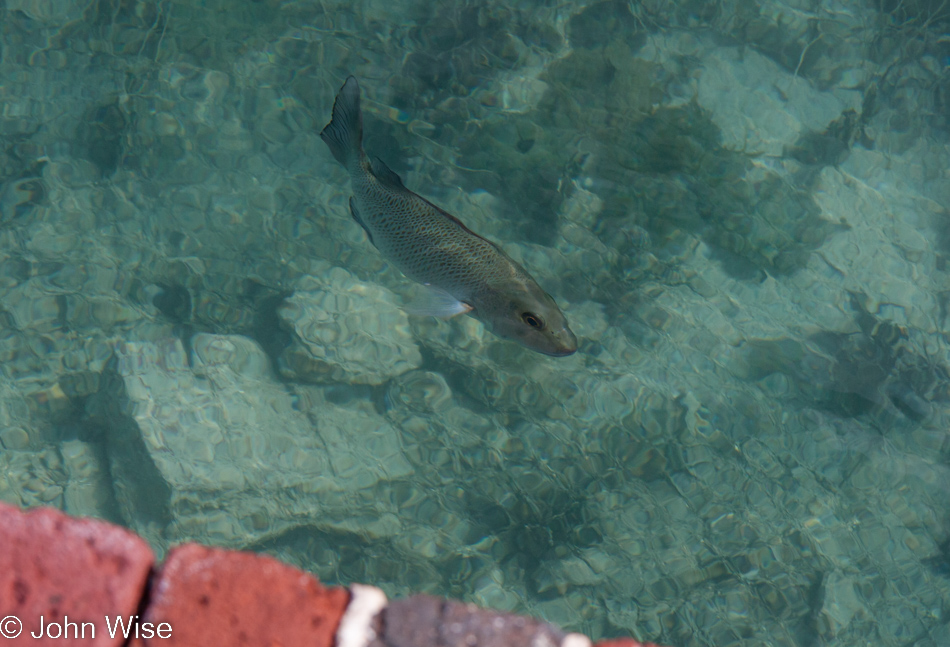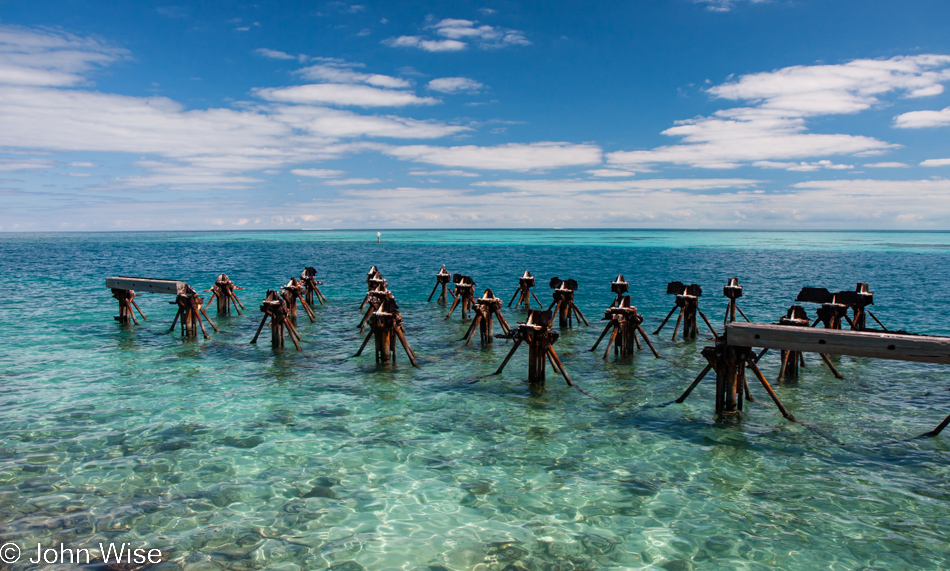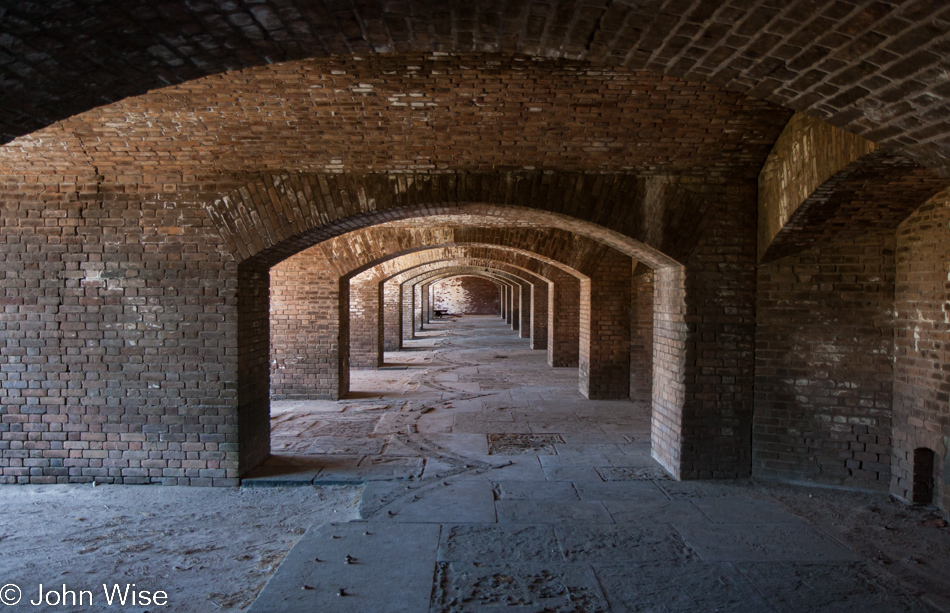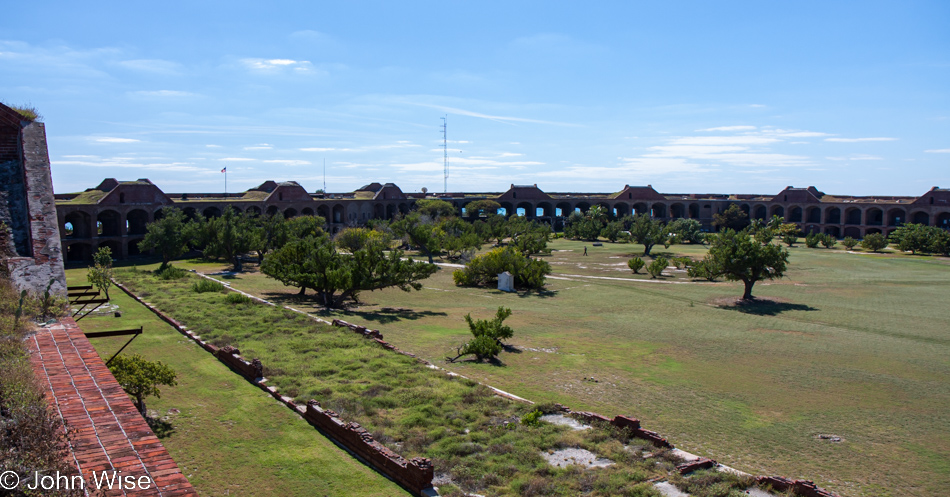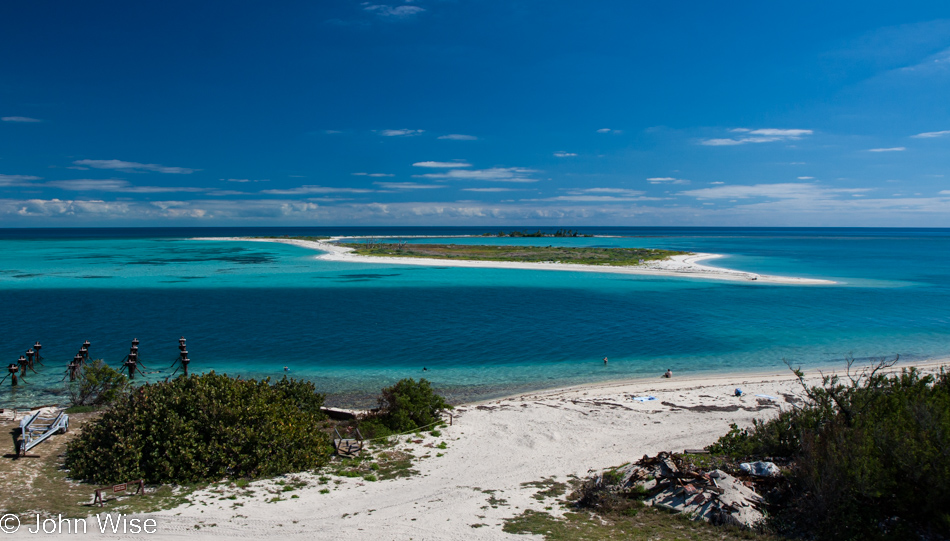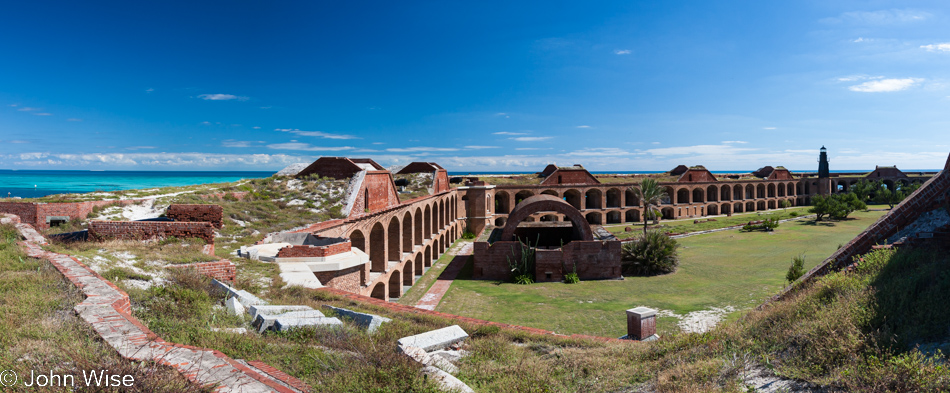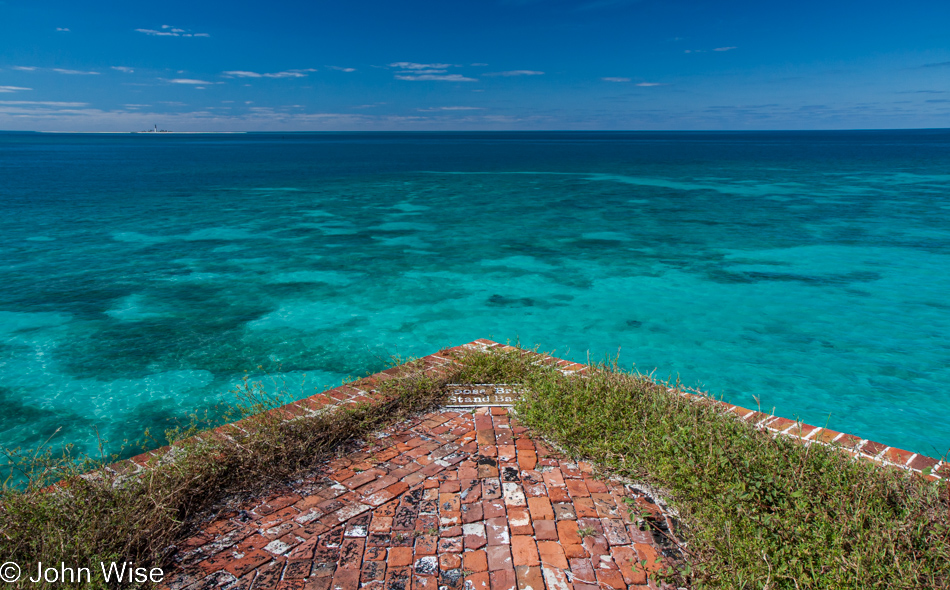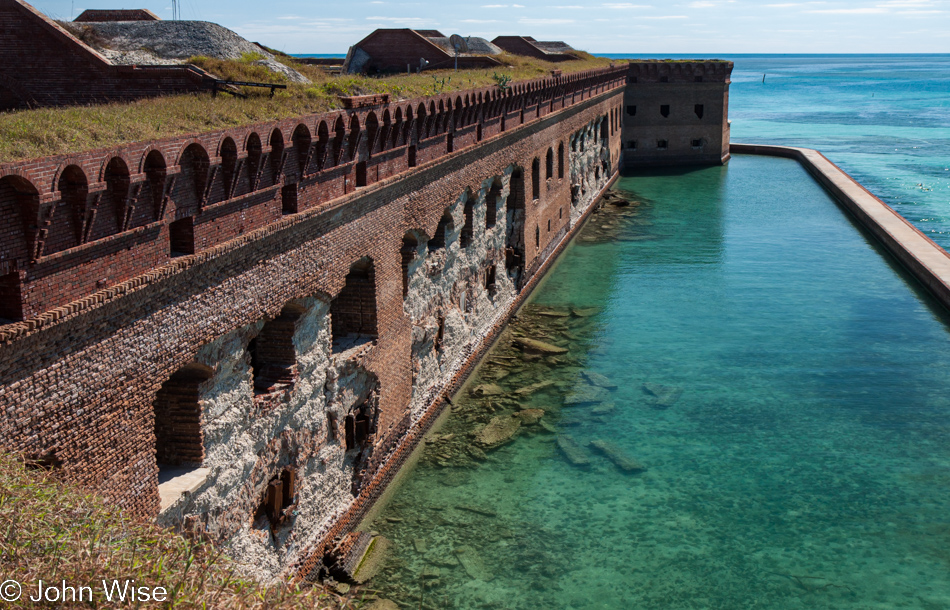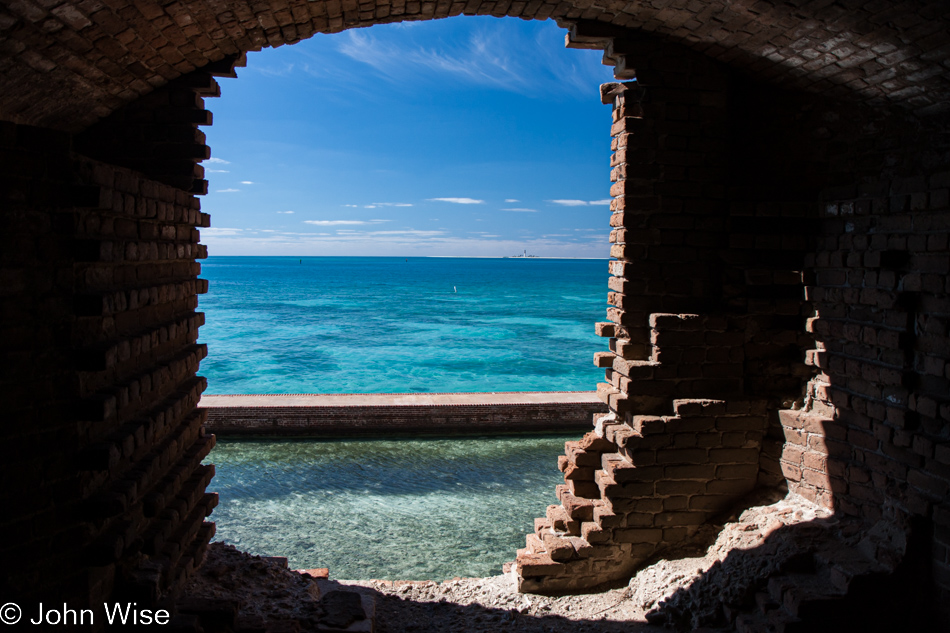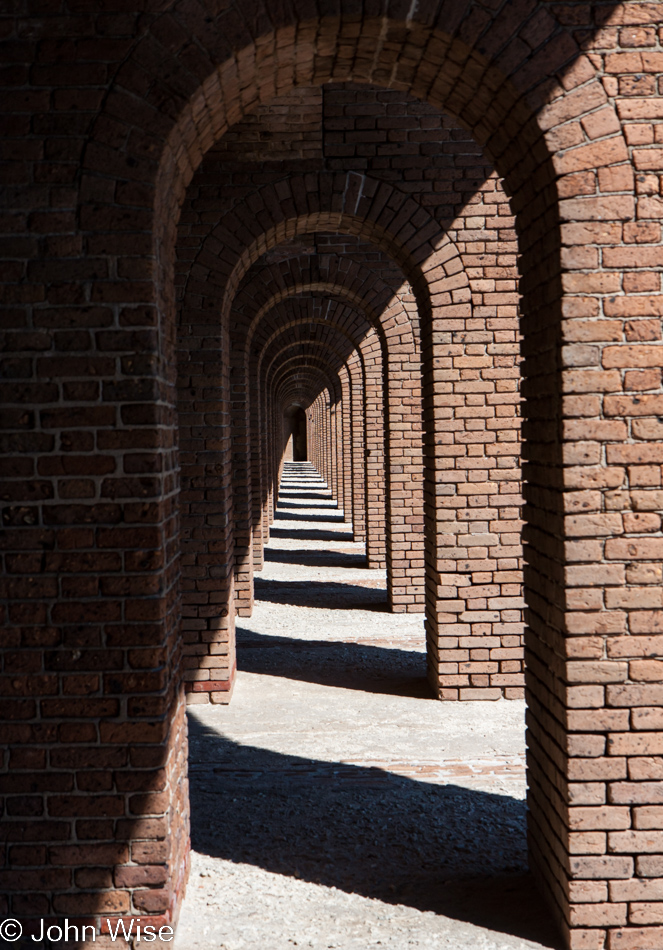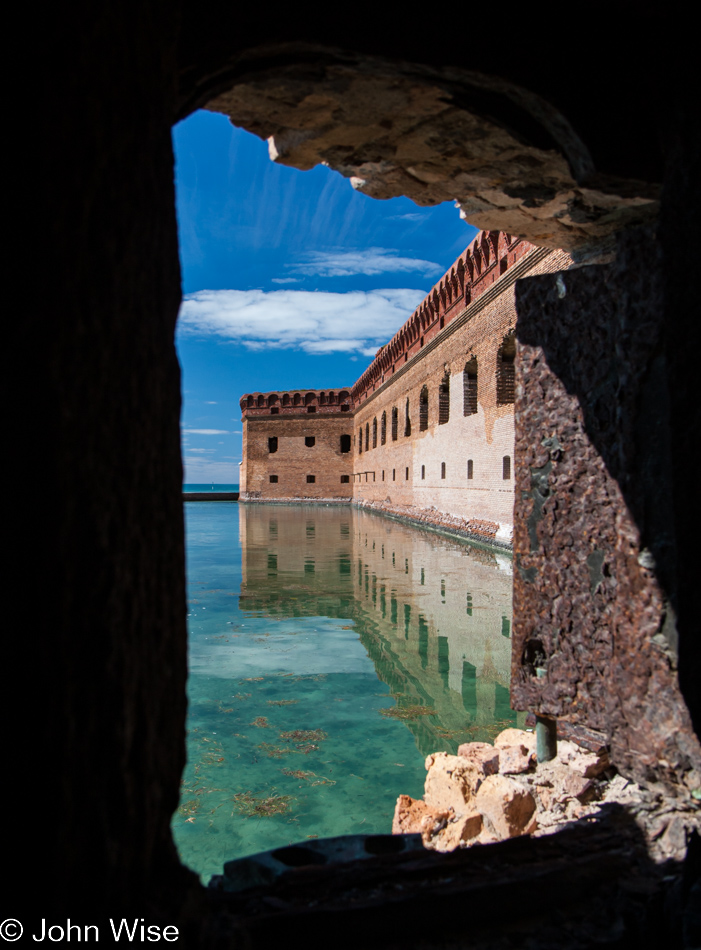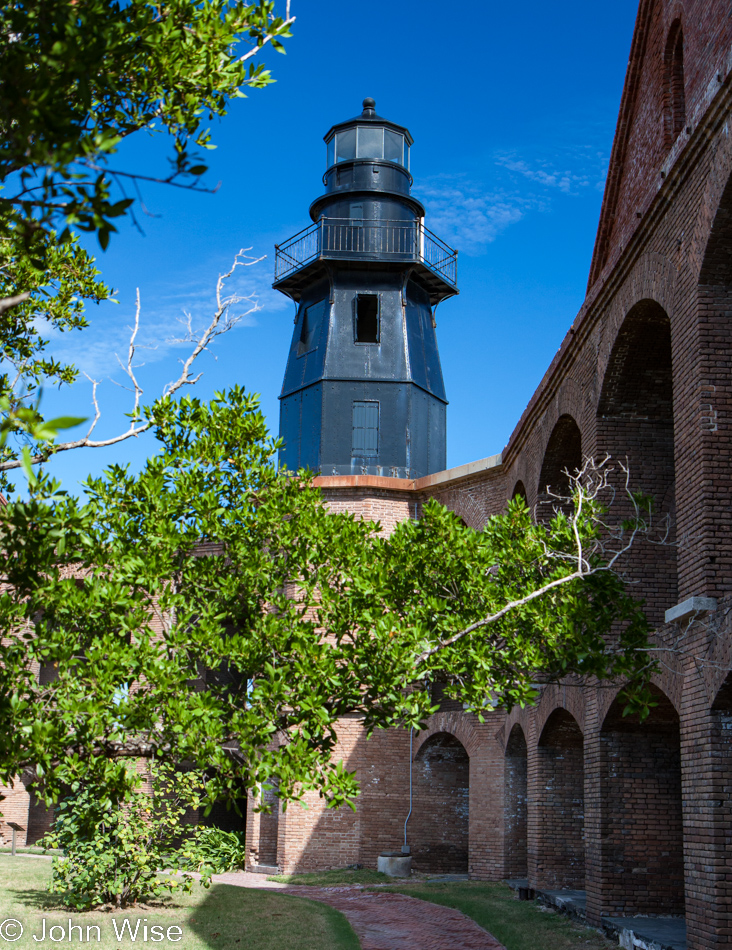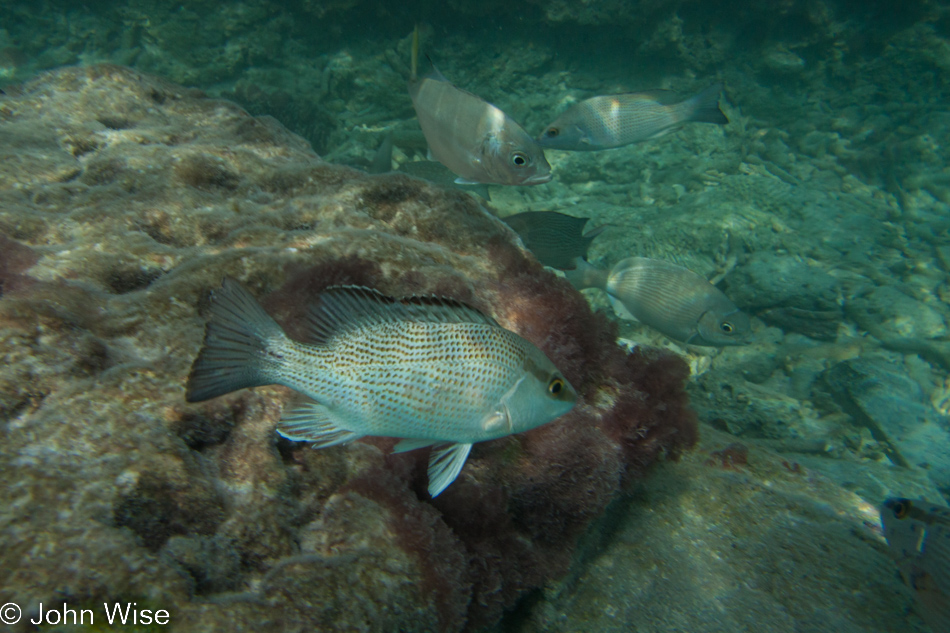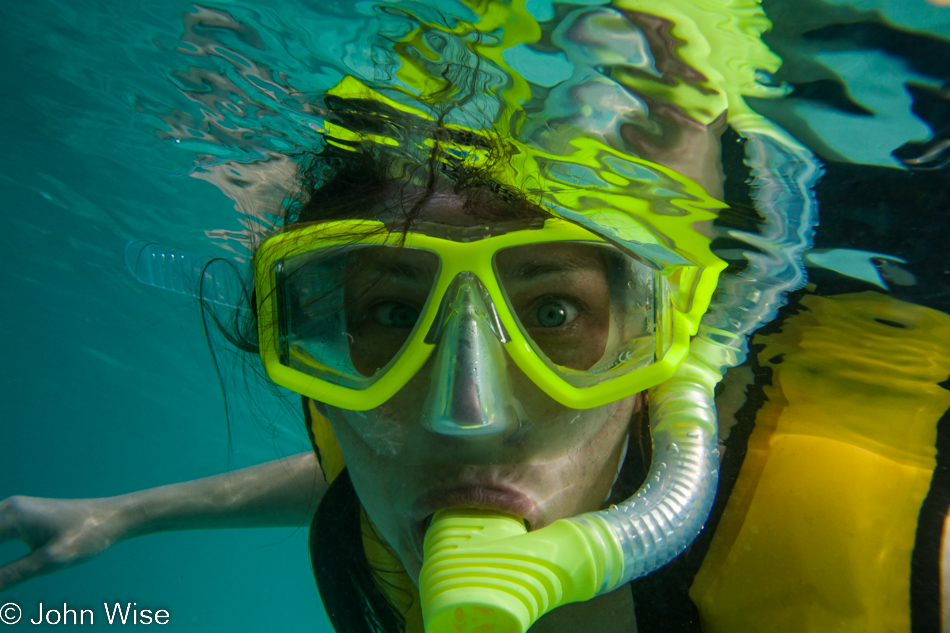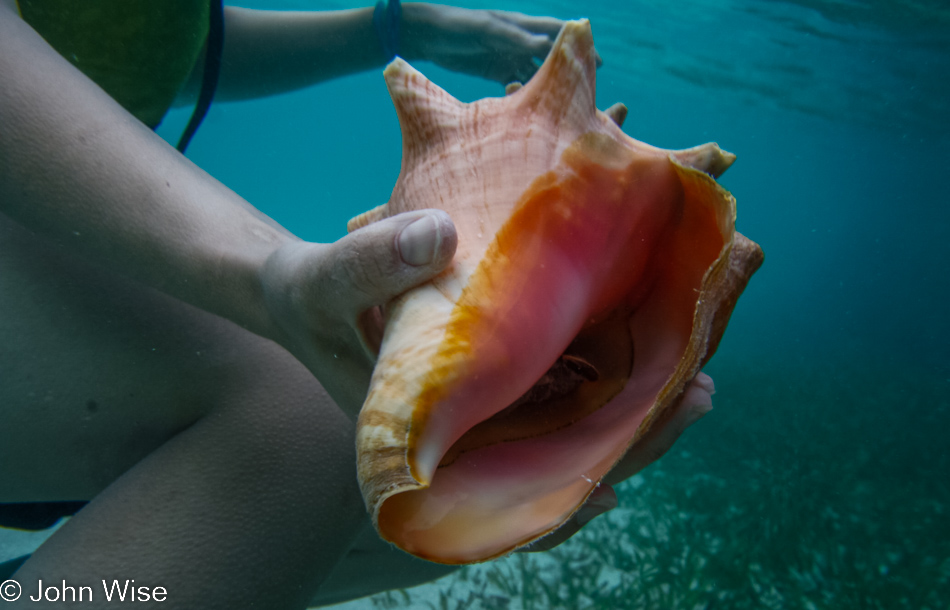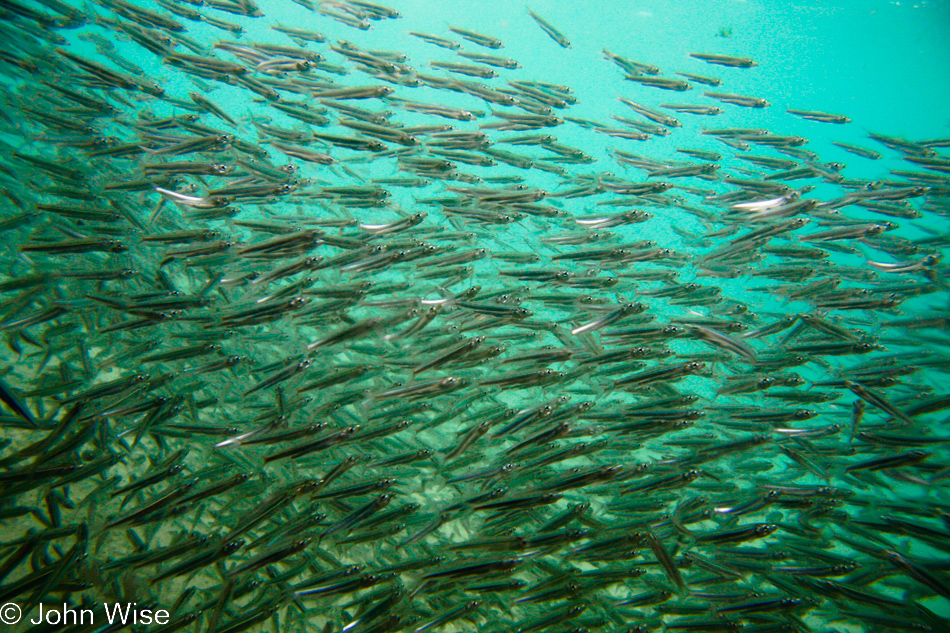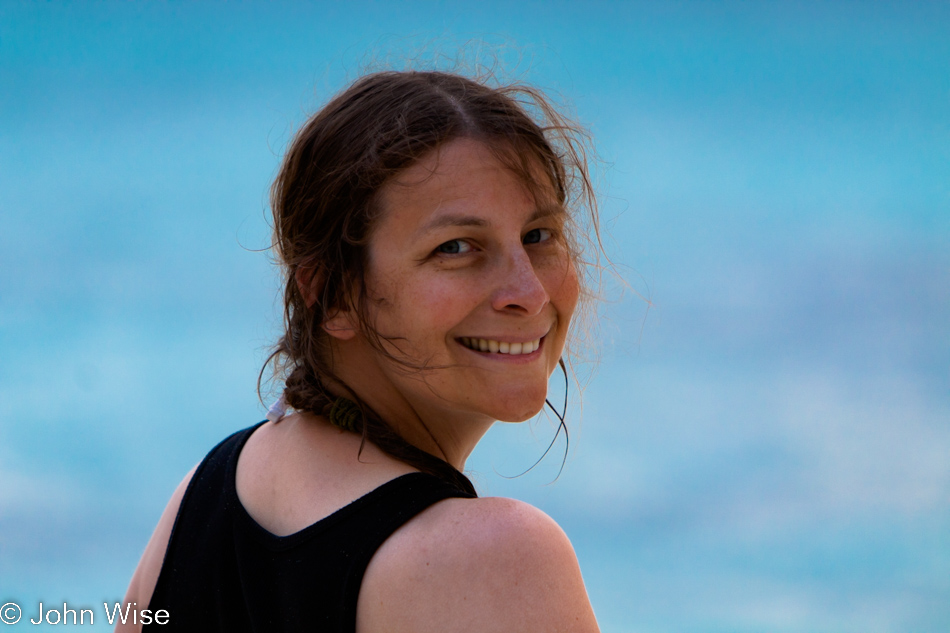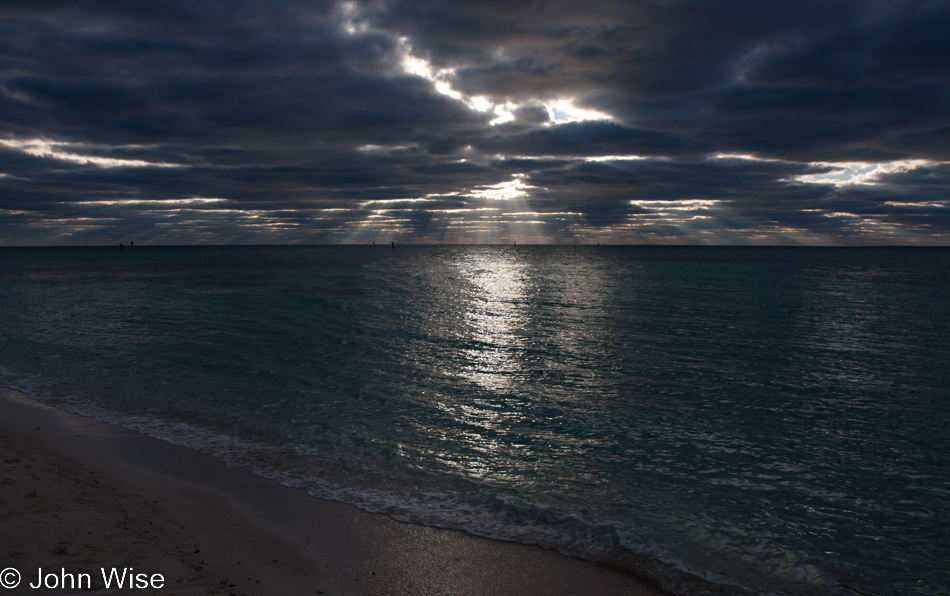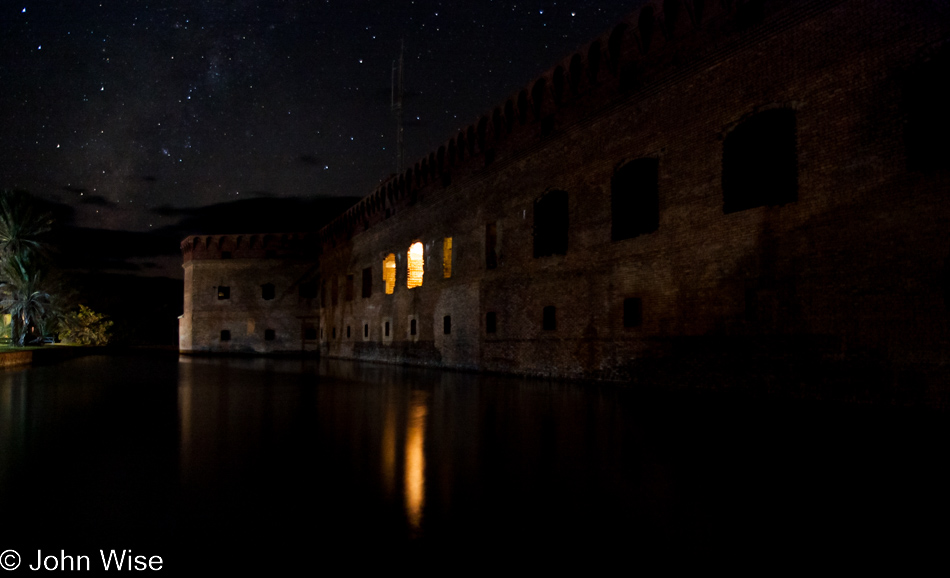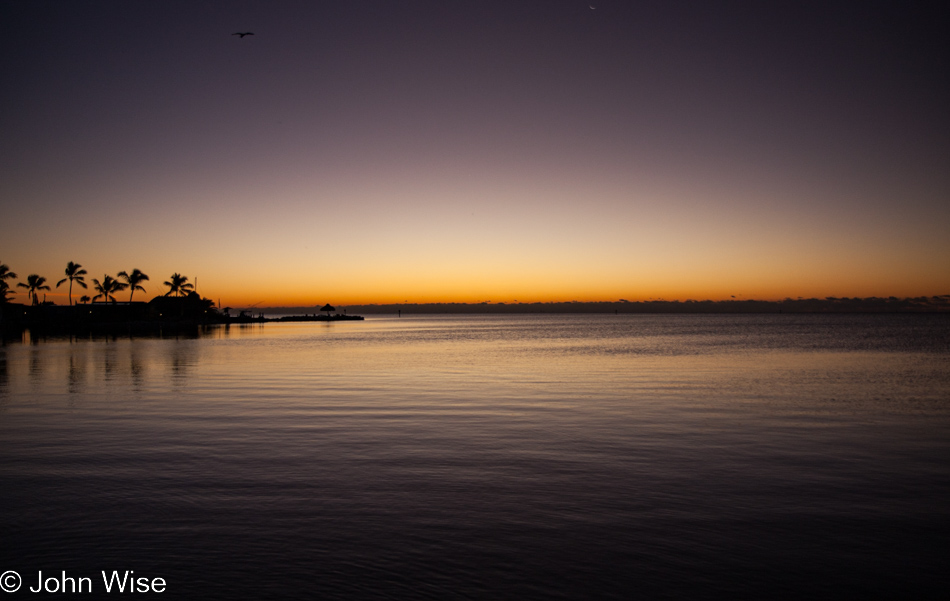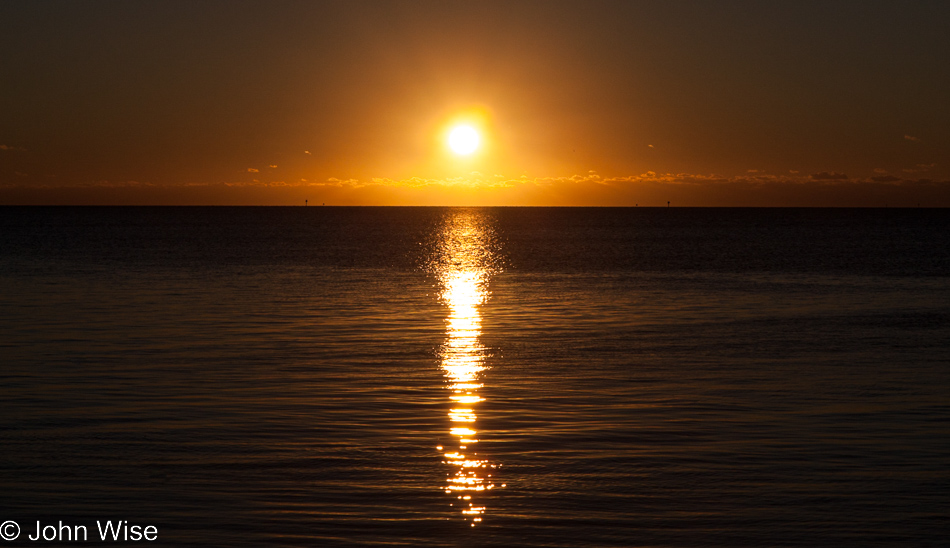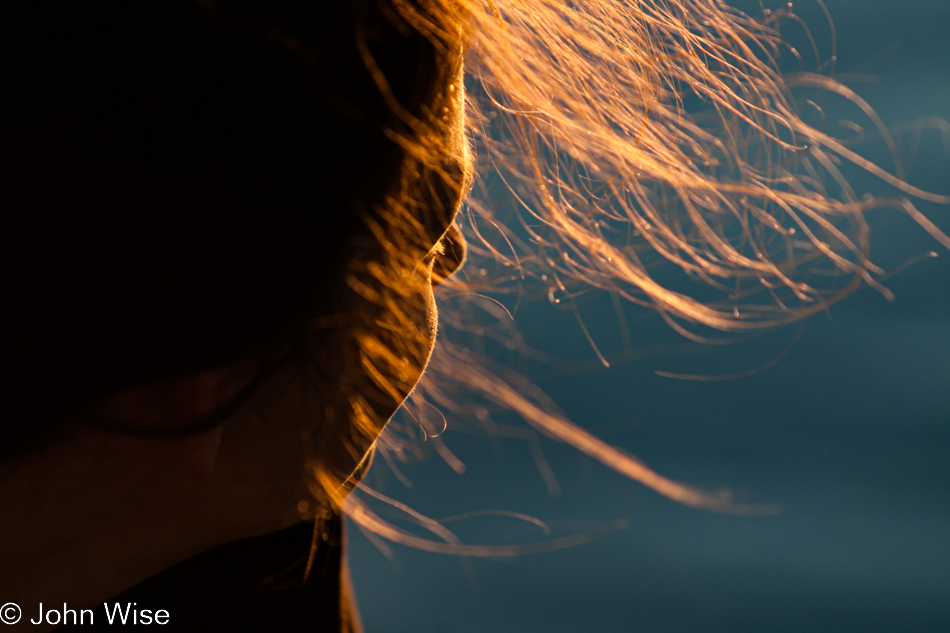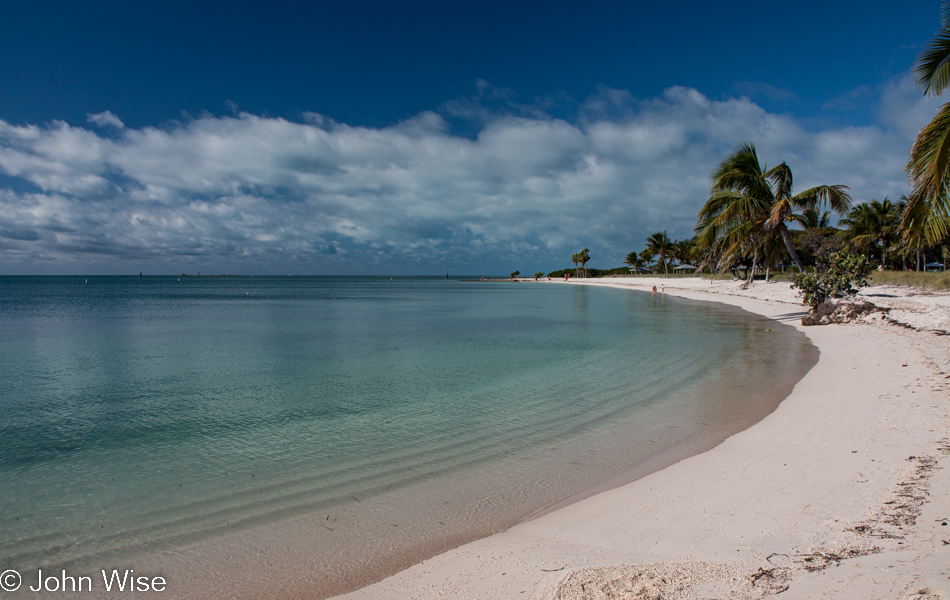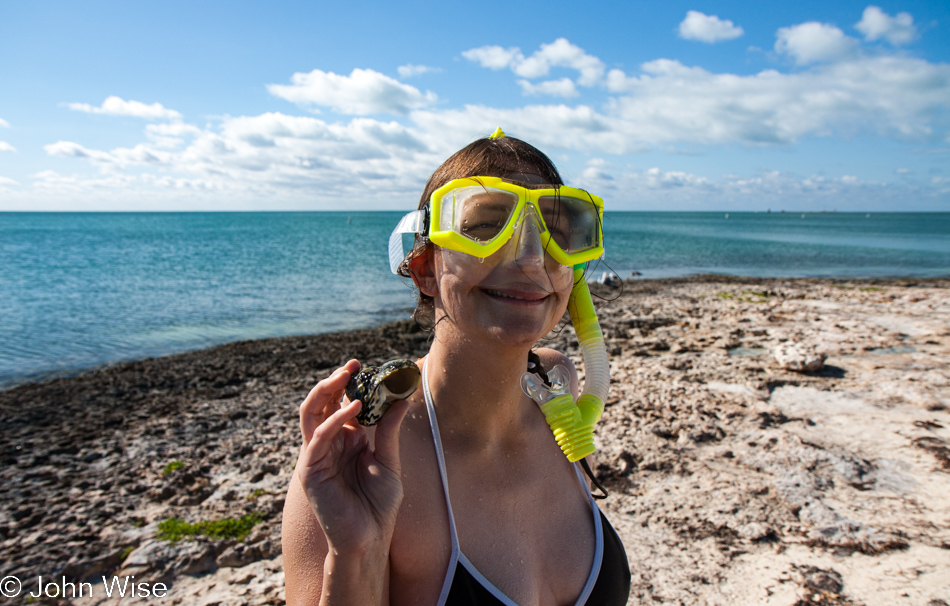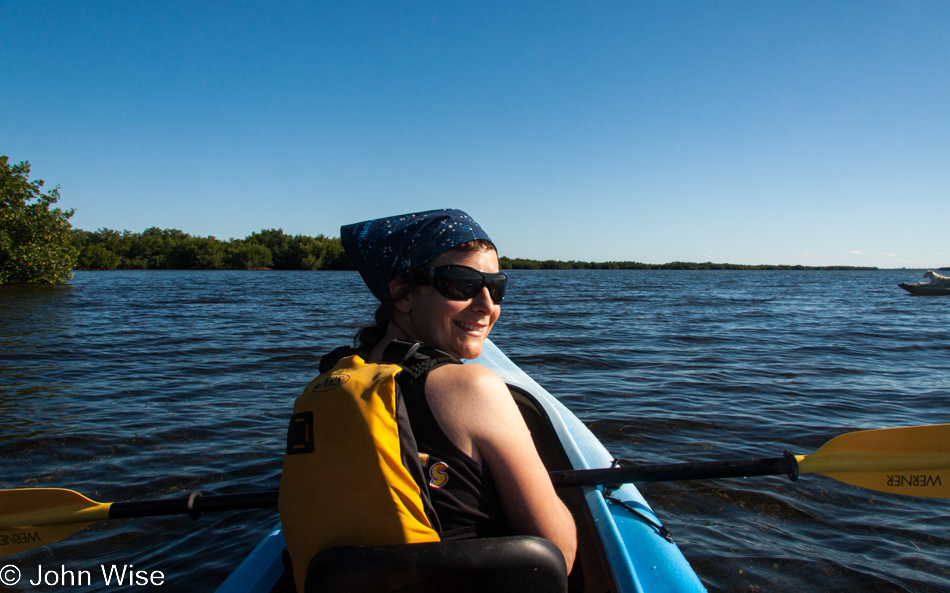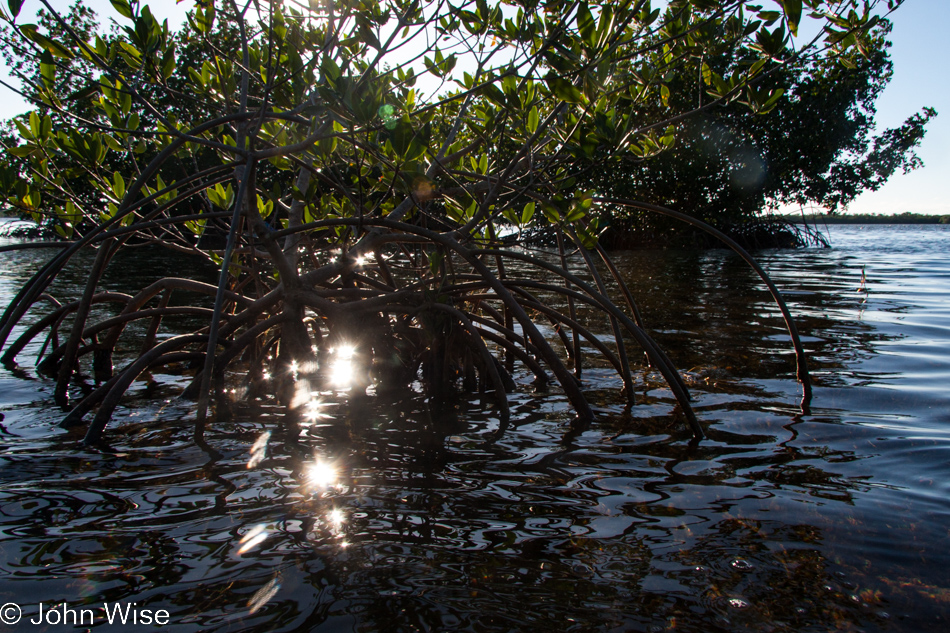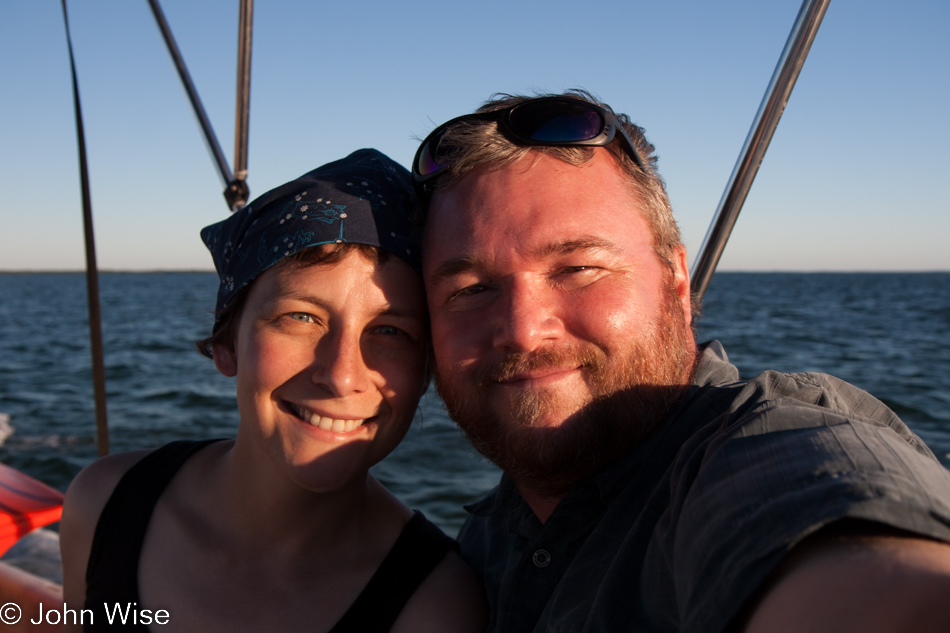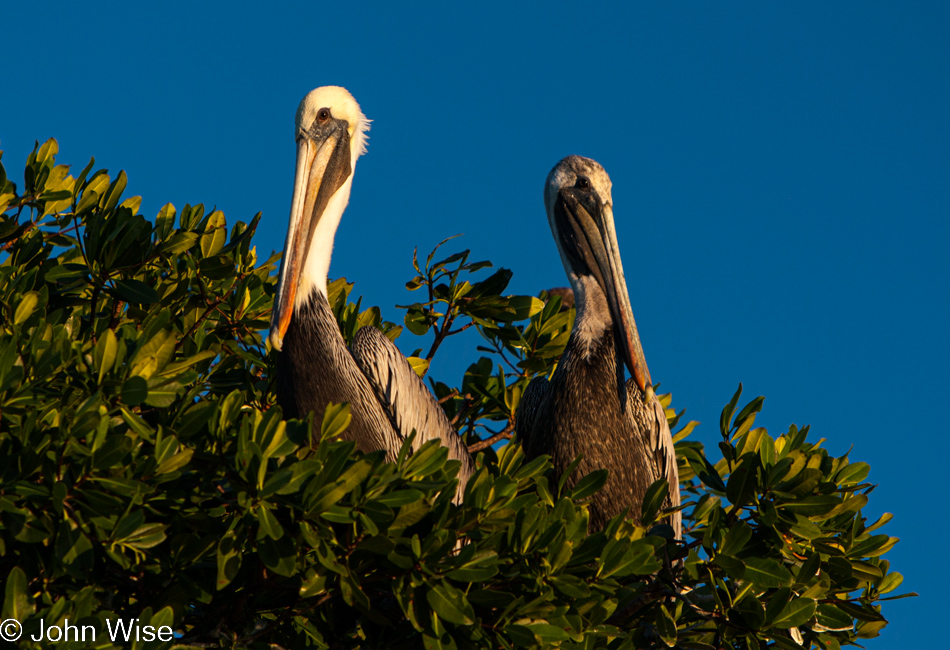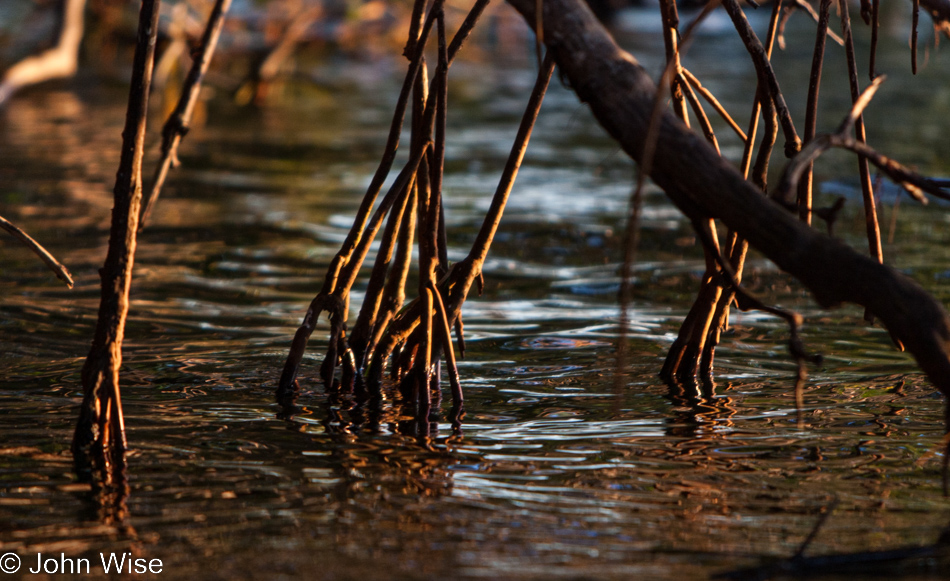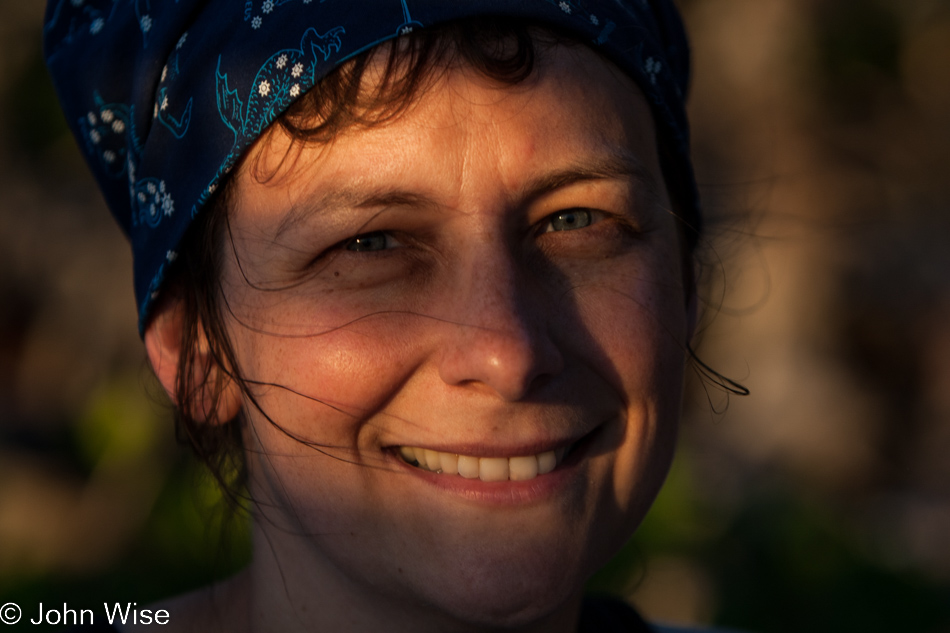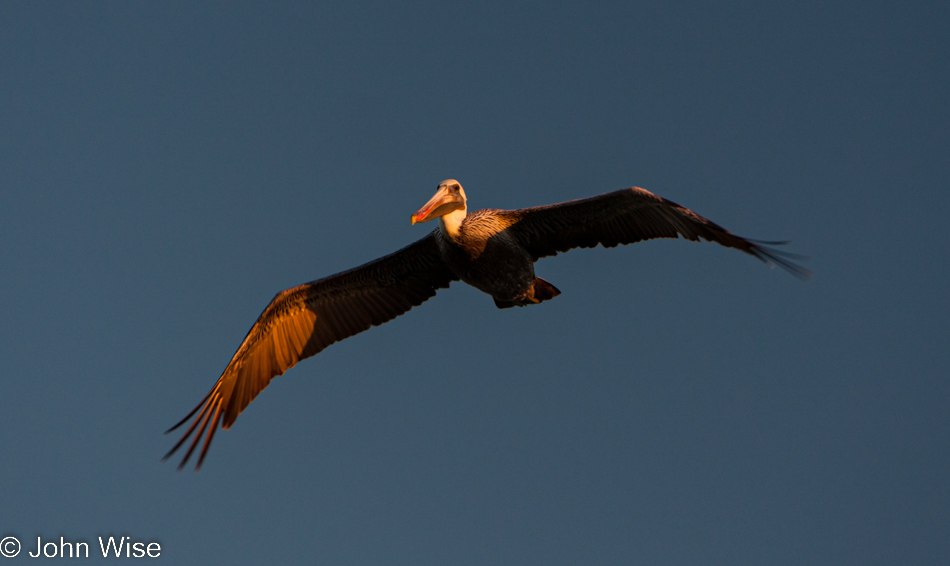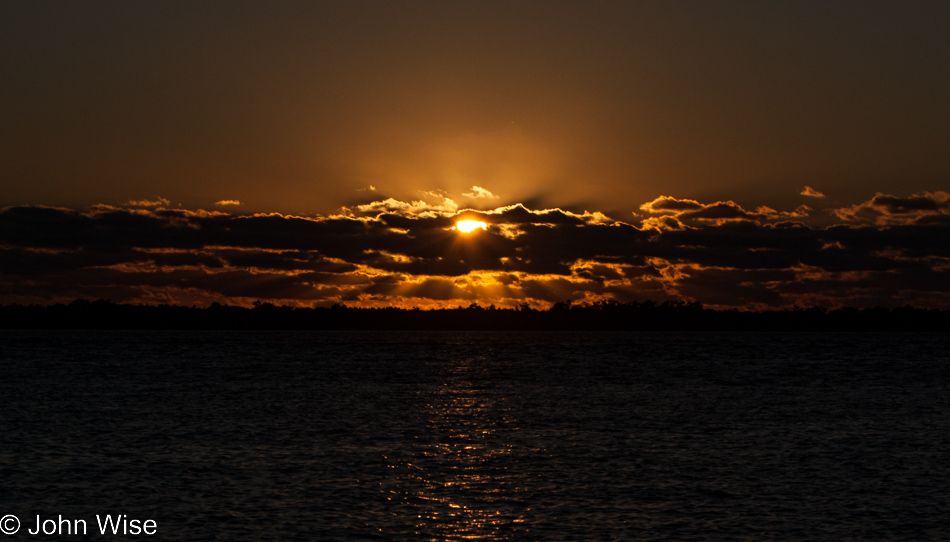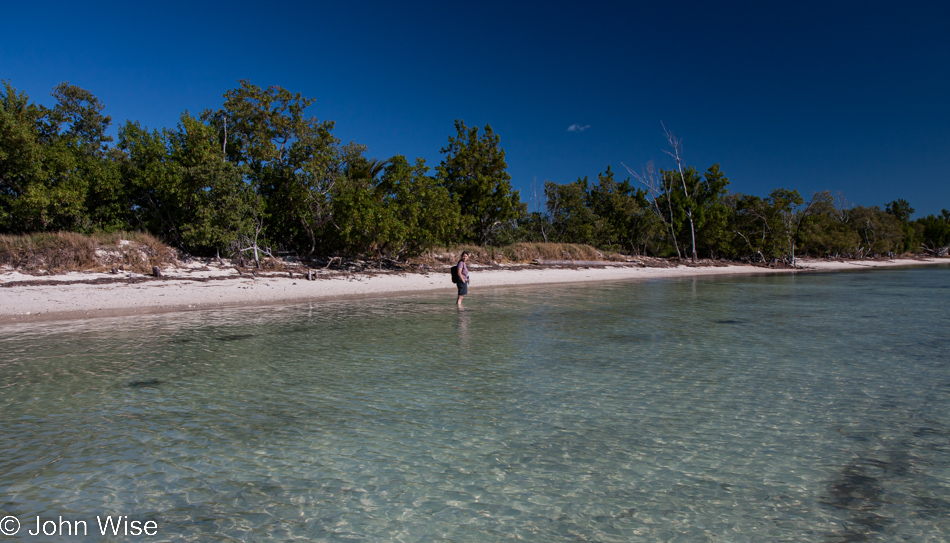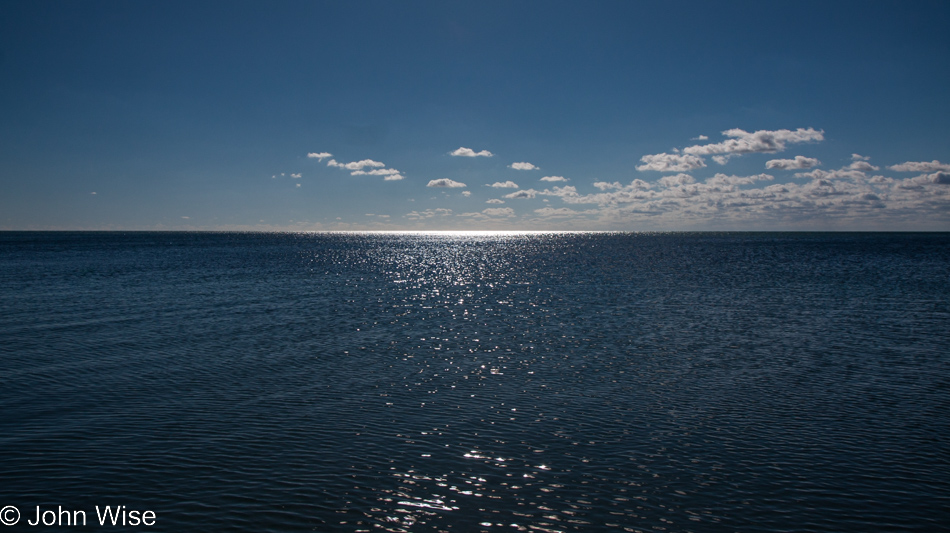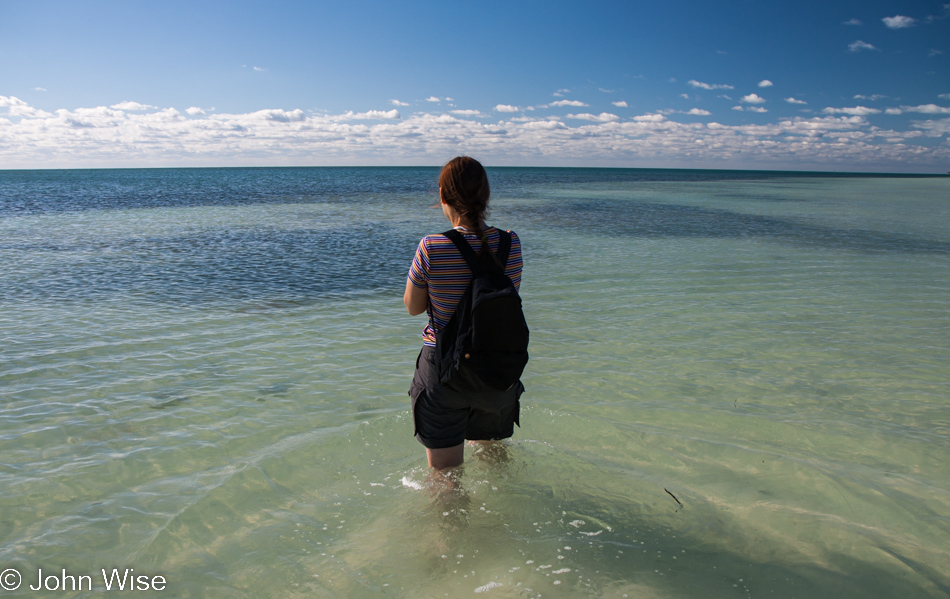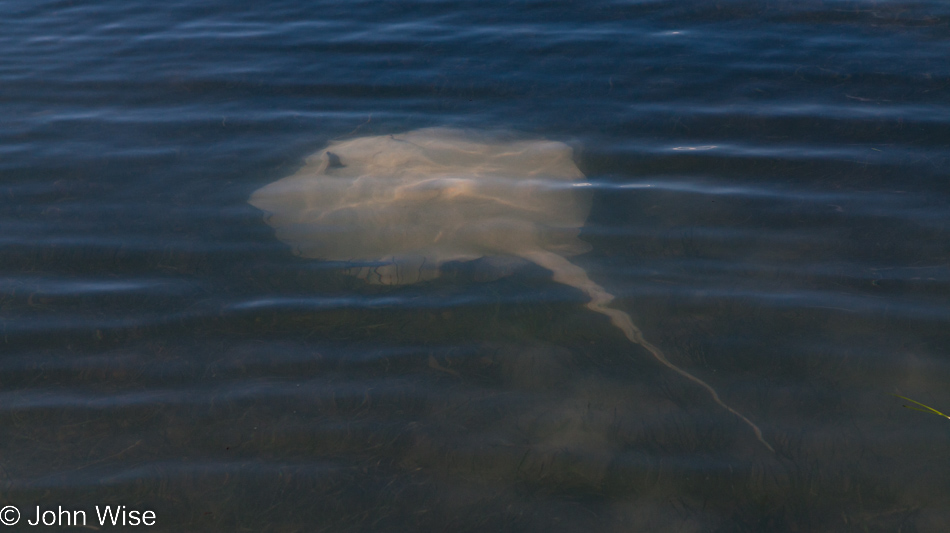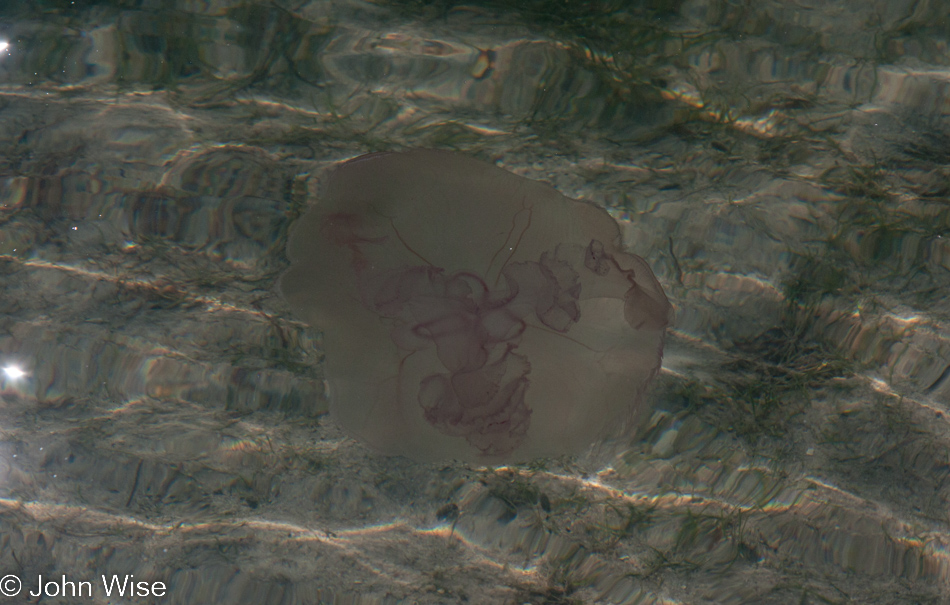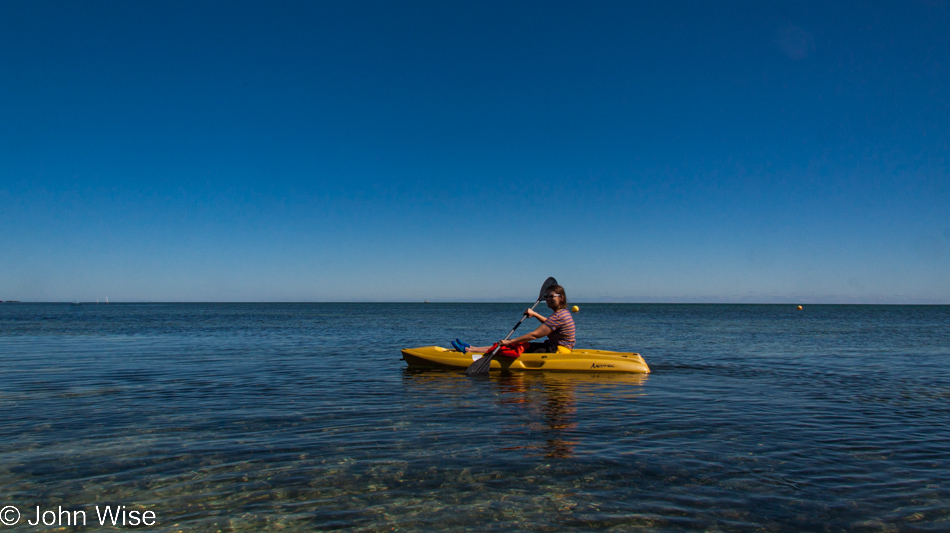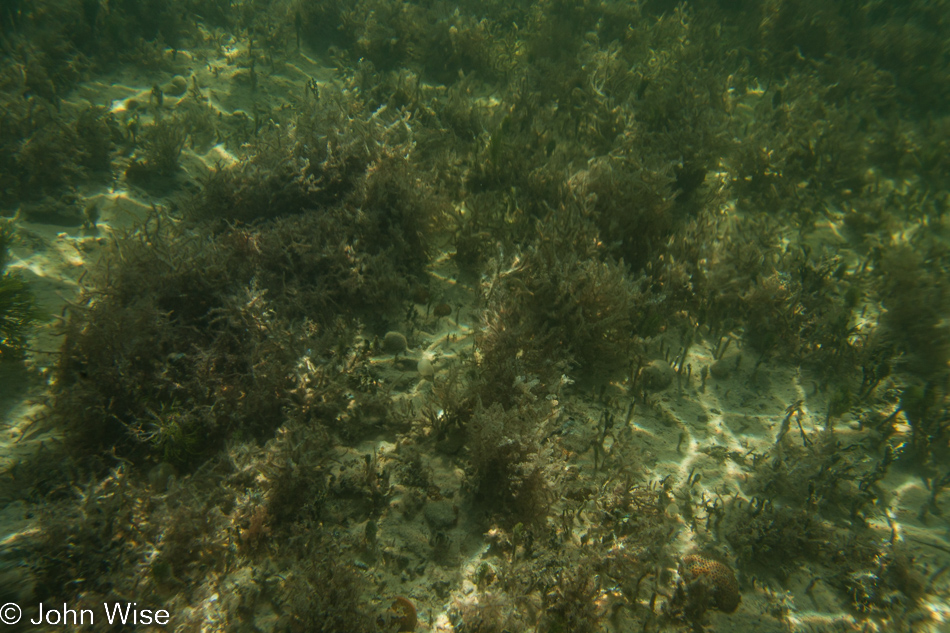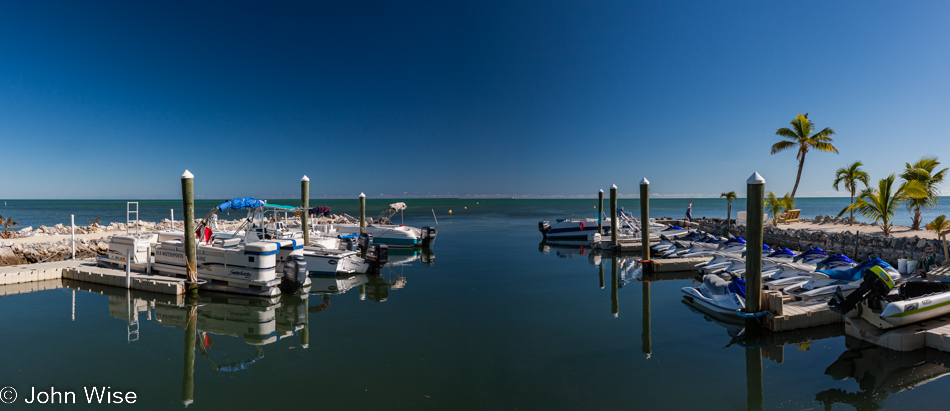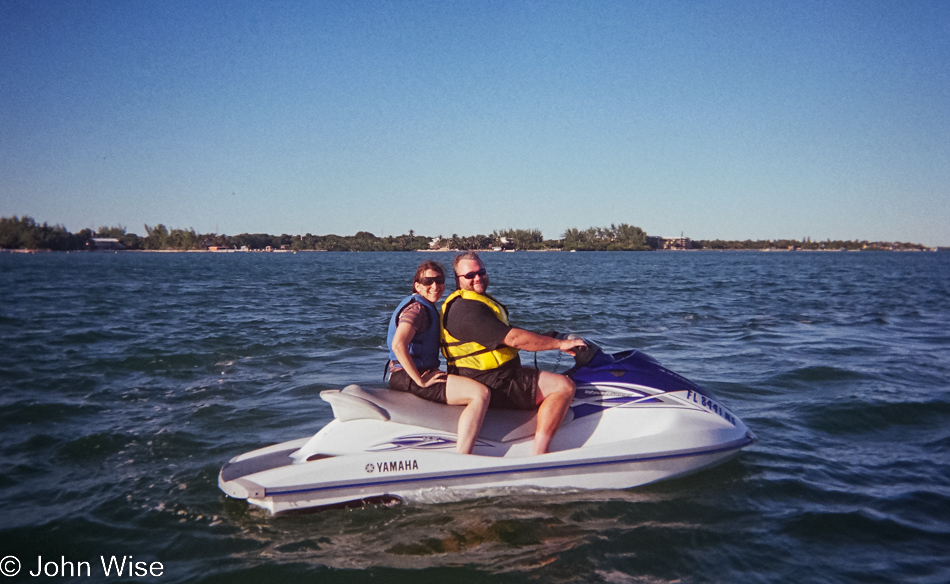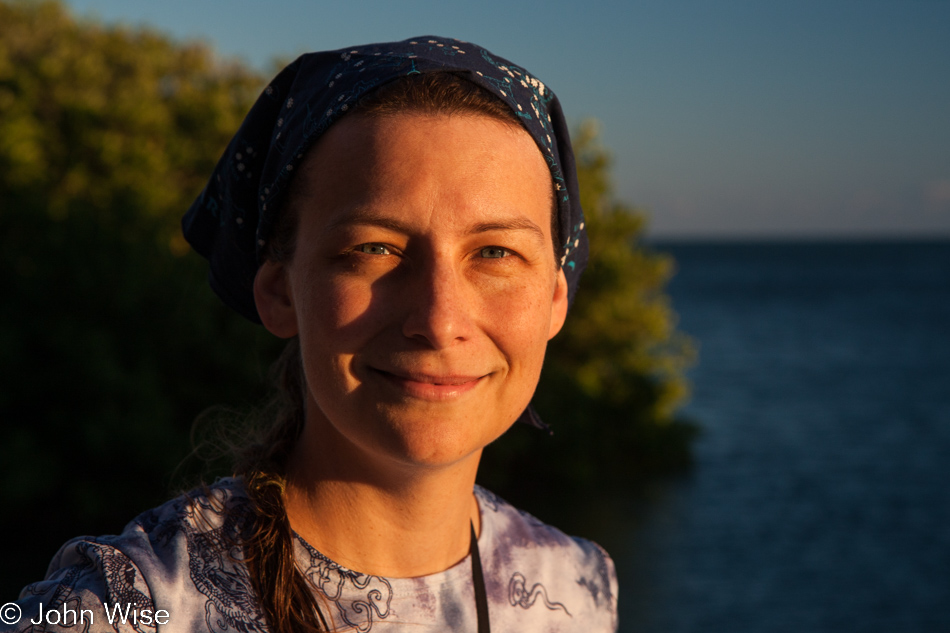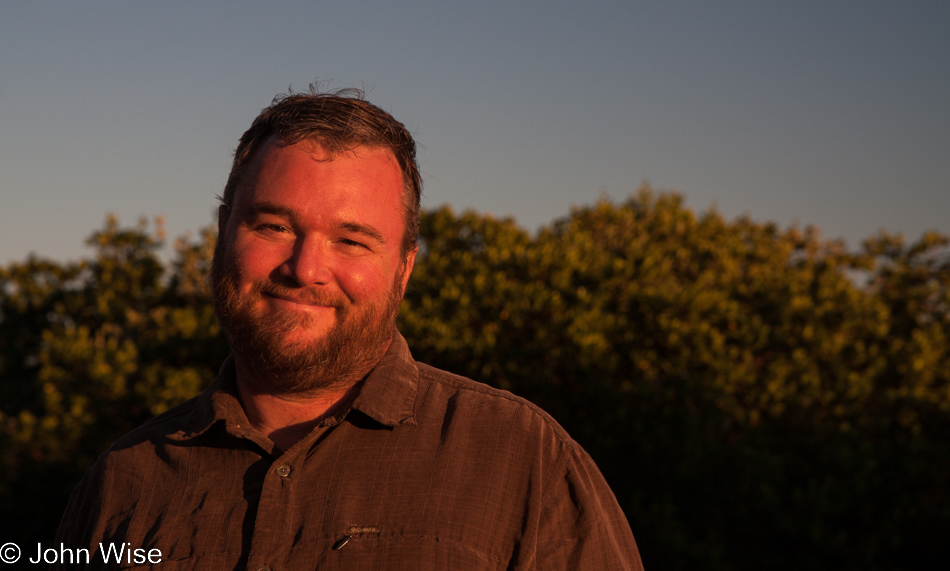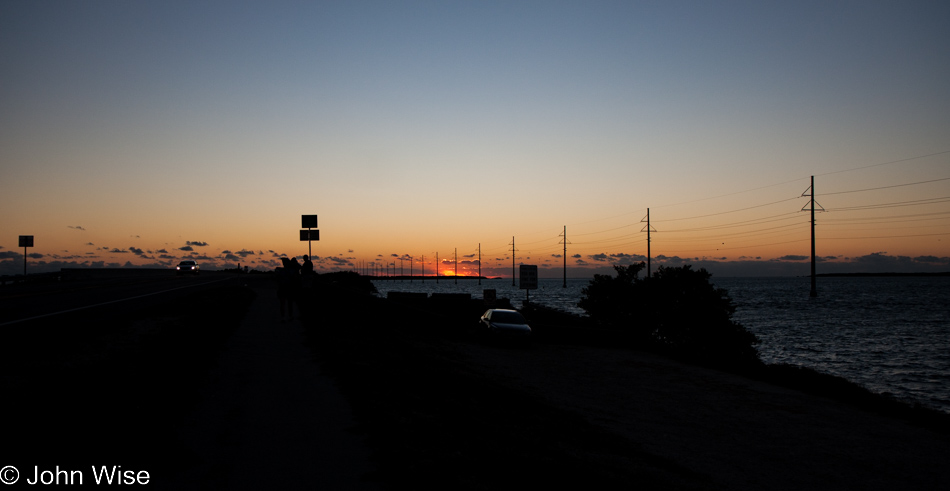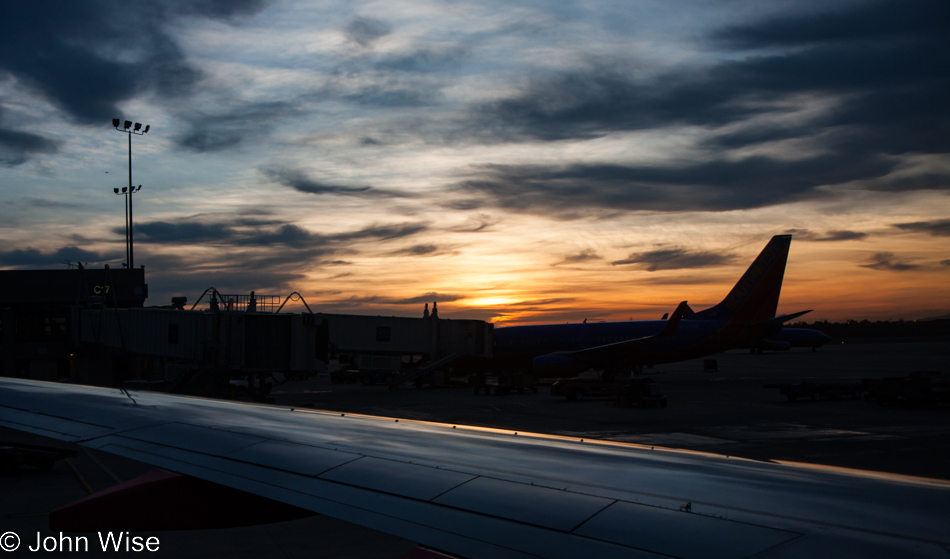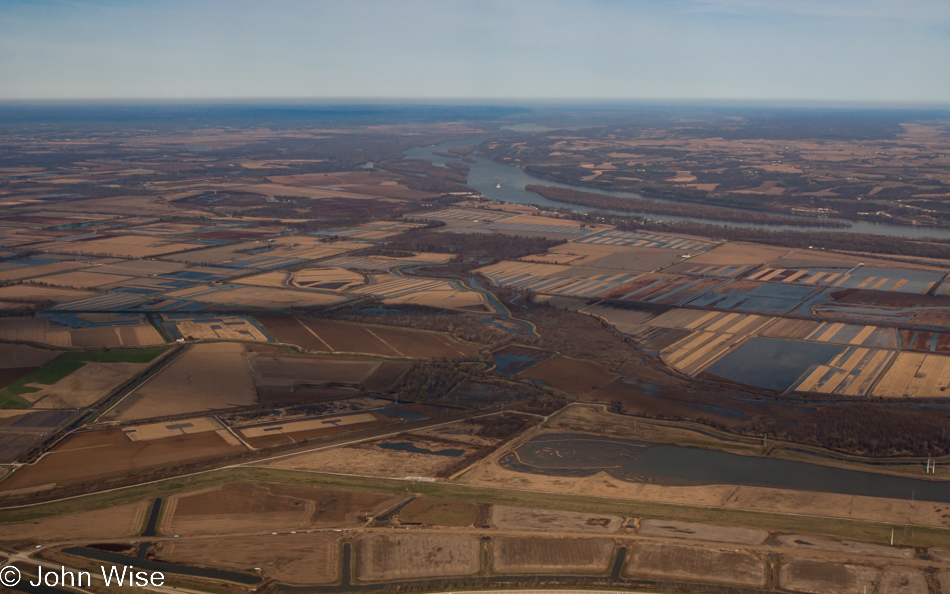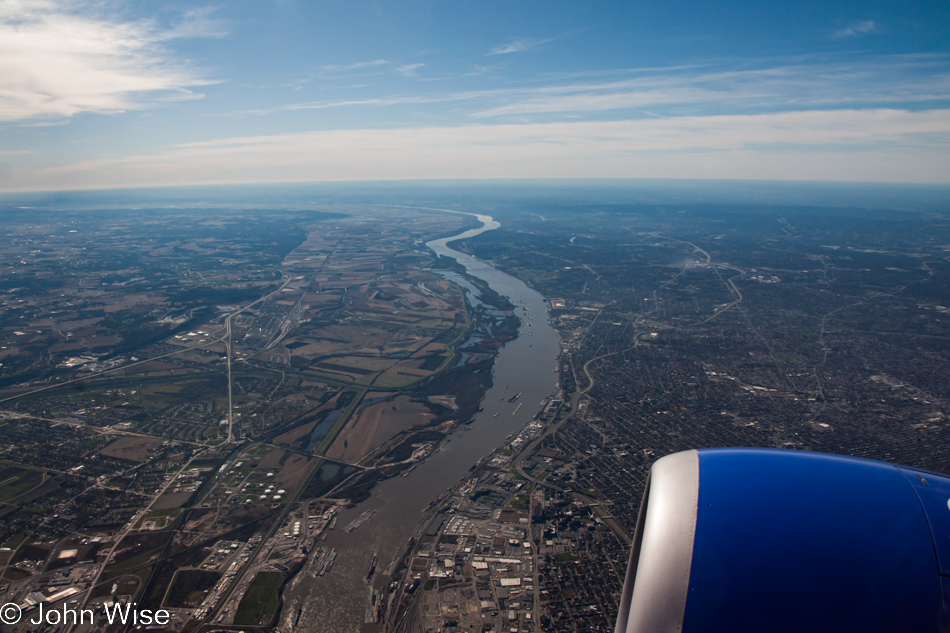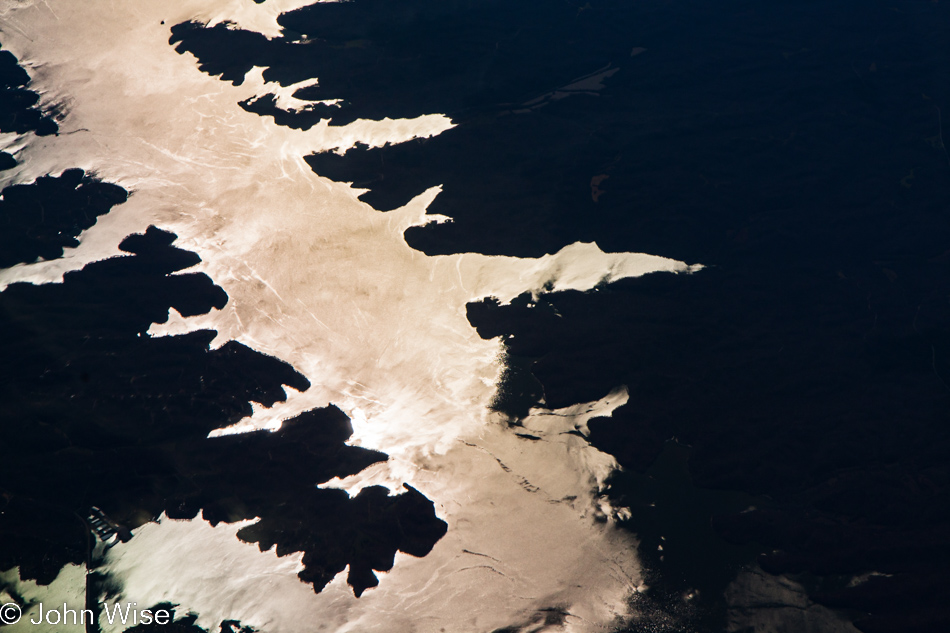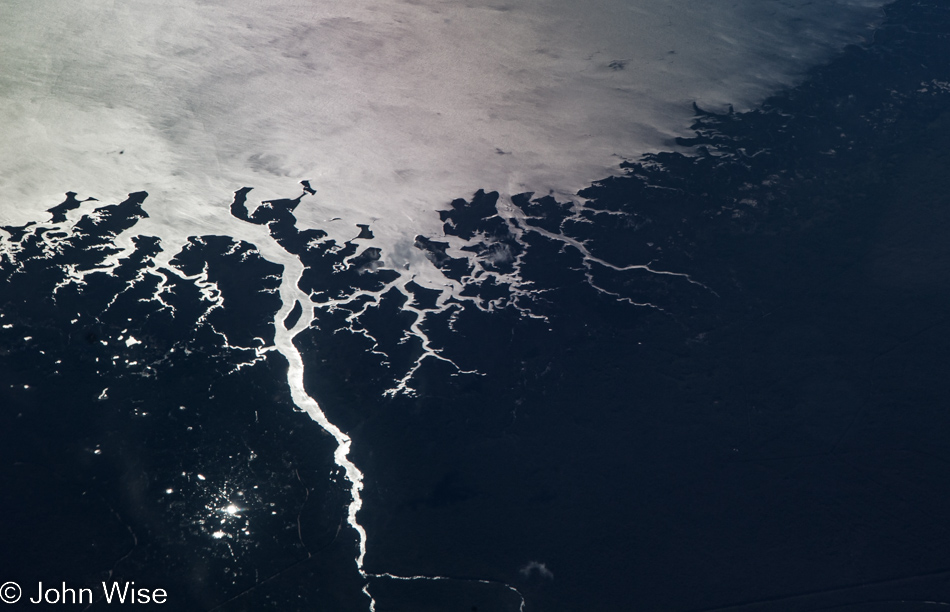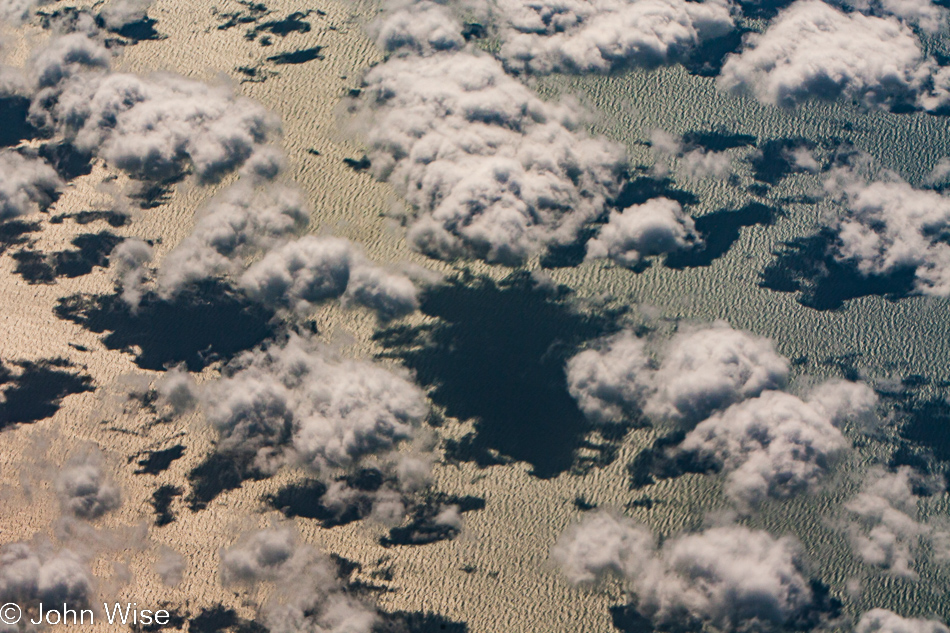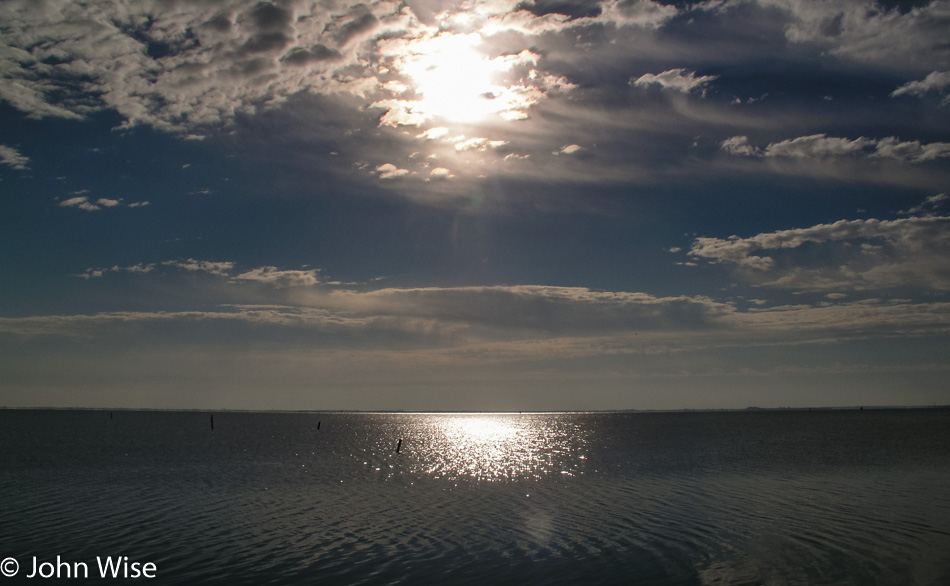
Thursday brings new life and new fun. The sun is shining after some lingering clouds gave way during the early morning. Our first stop is to catch a long-distance glimpse of the Space Shuttle Hangar out on Cape Canaveral and the Kennedy Space Center. Nobody other than myself has any real interest in walking around this corner of history and so we continue our drive north.
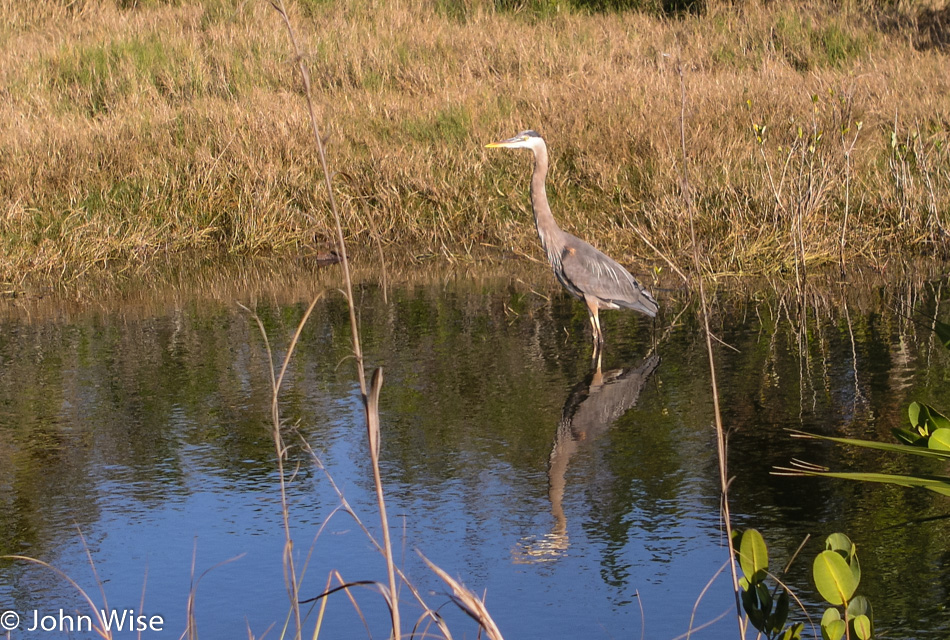
Merritt National Wildlife Refuge is the next place of interest, so we stop. This is home to a diverse collection of plants, birds, alligators, and insects, populating the many waterways and probably a lot of other stuff we can’t see. Blue herons and egrets are the most abundant birds we readily see. A couple of cormorants sun themselves while other smaller birds flitter by.
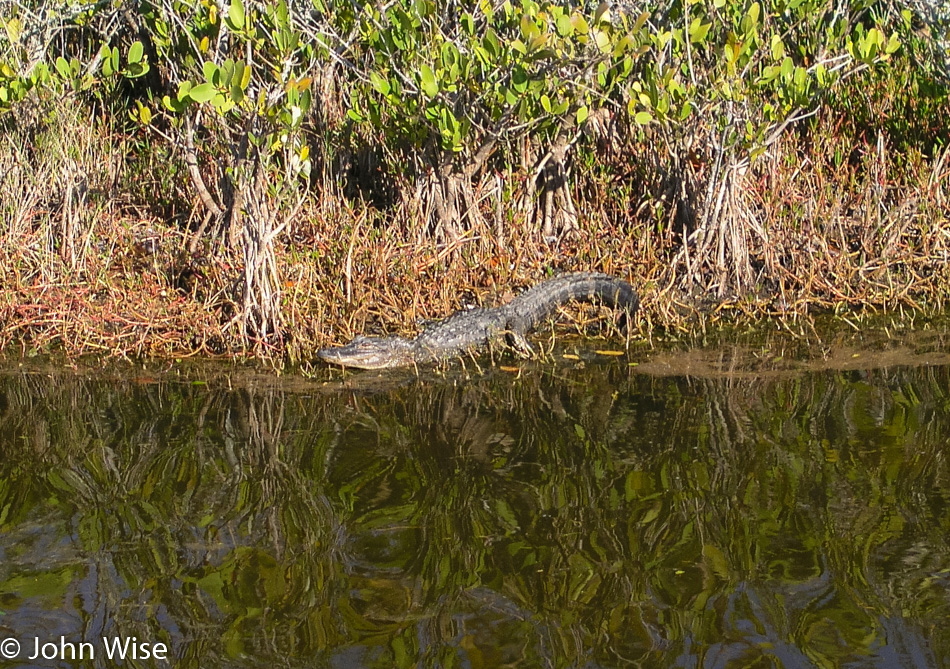
Over in the grass, a small alligator, or maybe it’s a big lizard, a very large lizard. The gator is about 4 or 5 feet long and poses while we gawk. This gator will be the only one we see today, which is unfortunate as Auntie was hoping to see a capital specimen.
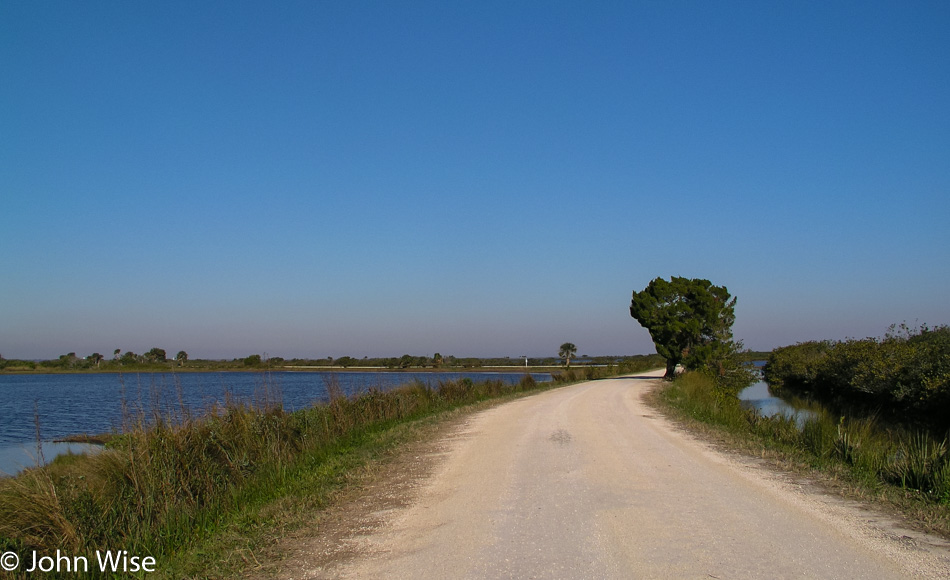
Crawling along at five mph, we see more birds, admire the thistles, and get lost in the ripples of water scattering sunlight across its surface. The road through the refuge is a short one with just a few interpretive signs along the way.
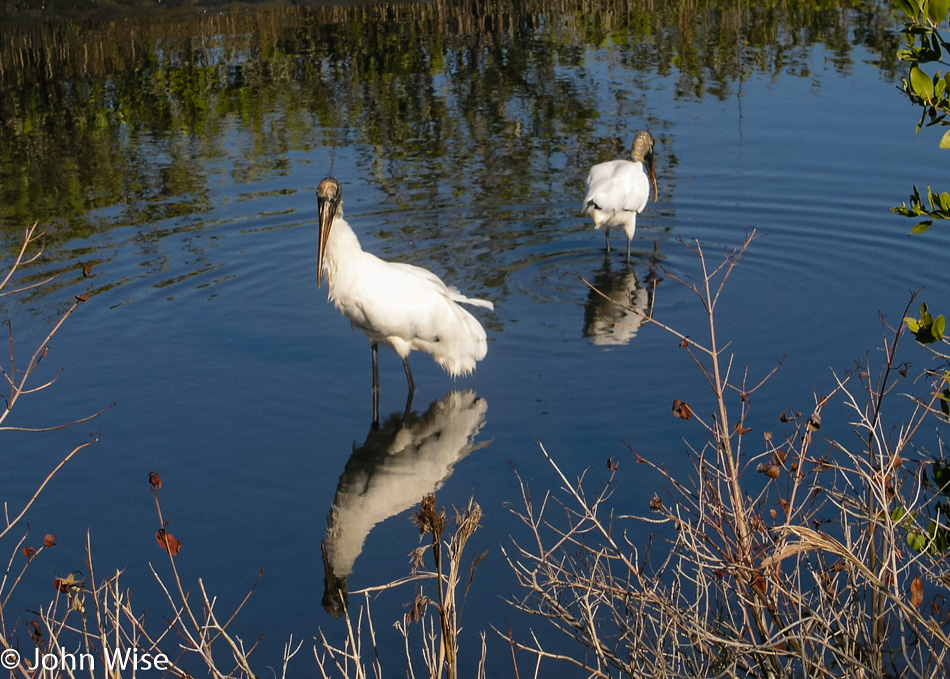
We passed a manatee viewing area, but from previous experience, I have learned that these sea cows need more heat than the frigid winter waters can deliver. The manatees go inland to find those warmer waters. What we don’t pass is a gas station for replenishing our water supply and Grandpa relieving his own. Time to go find some of the essentials for continued comfortable travels.
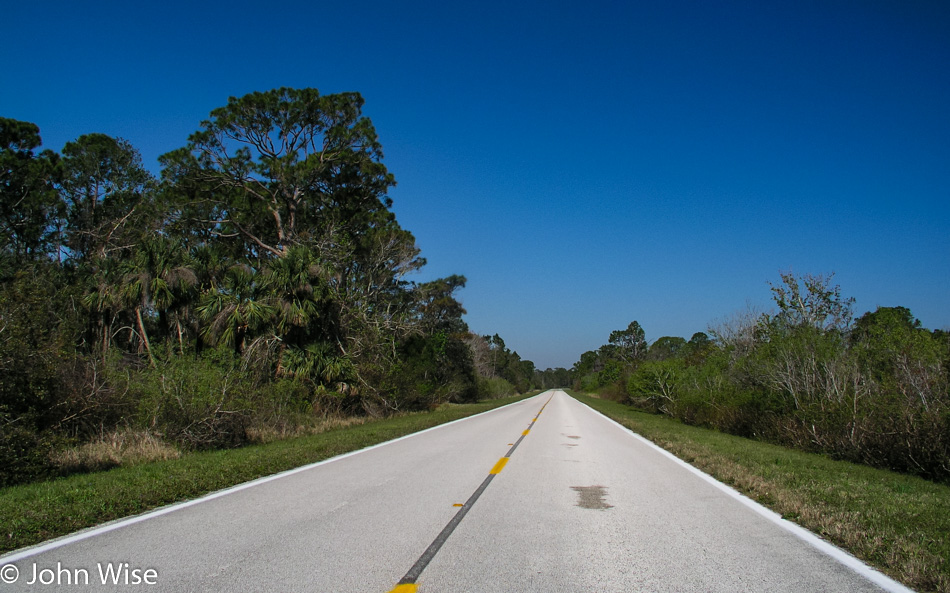
On the main road again we pass a few boat launch areas and quickly are at the end of this road and joining another where we find a gas station.
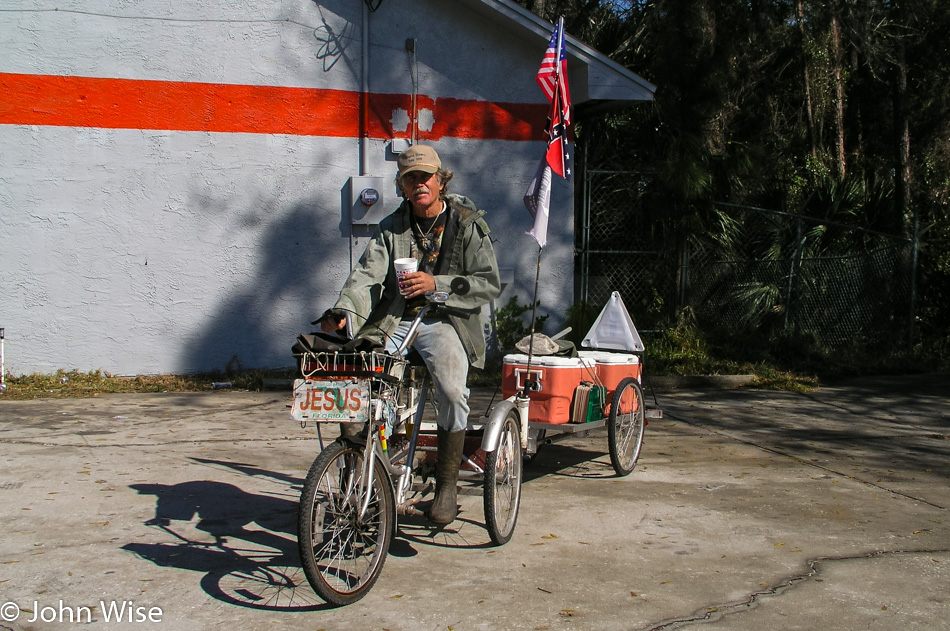
Leaving the gas station, a guy on a bicycle sits waiting for us to pass. A Vietnam Veteran with strong feelings for Jesus, he is Mr. Tougher T. Woodpeckerlips, T stands for Than. Not being able to pass this sight up, I ask to take a photo, which he obliges.
He asks where we are from; we ask him the same. He offers up some excellent information about the forest here with panthers and other wildlife that can be seen in the wild. Sadly, we are short on time and have to leave, but not before he tells us how he rows, standing up on his 16-foot flat-bottom fishing boat, rides his bike everywhere, and was recently hit by a car from which he is still recovering. It was after the list of battles that he adopted the description of being “tougher than woodpecker lips.”
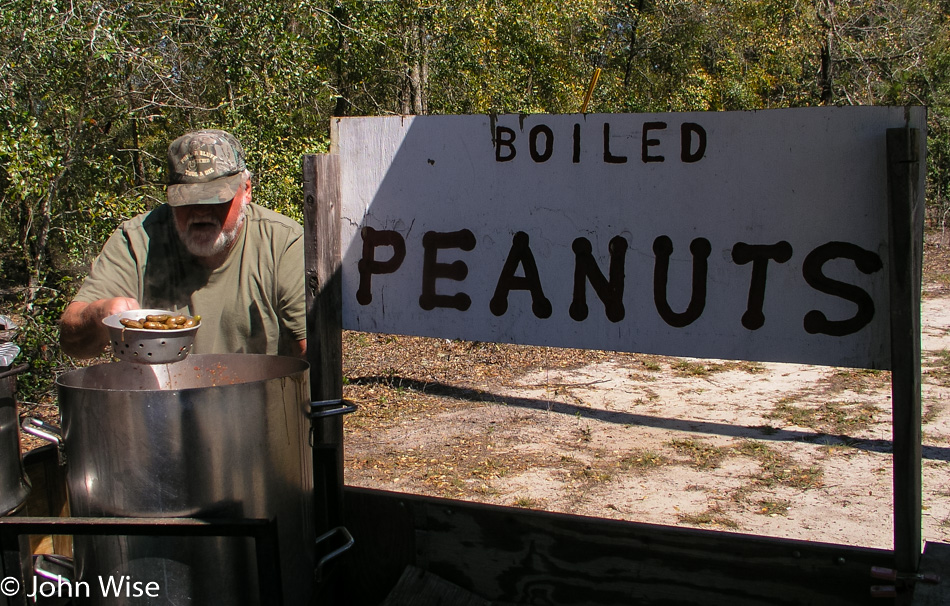
That’s it, we are as northeast as this trip takes us. I point the car west, and we are now truly on our way home. Luck shines like the sun today. Not far down the road, we spot a man selling boiled peanuts. I have been looking for fresh boiled peanuts for more than a thousand miles now and need to stop.
I wanted the real thing and not some plastic-wrapped, made yesterday, boiled peanuts that are some garden variety, boring kind. I had to have the cooking-on-the-side-of-the-road, out-of-a-pickup-truck-trailer variety. Better yet, they need to be served up by someone out of Dukes of Hazard, and that’s what I got. Cajun-flavored boiled peanuts served up by the bearded old man sitting with his dog on the roadside, waiting for probably anyone but us Yankees.
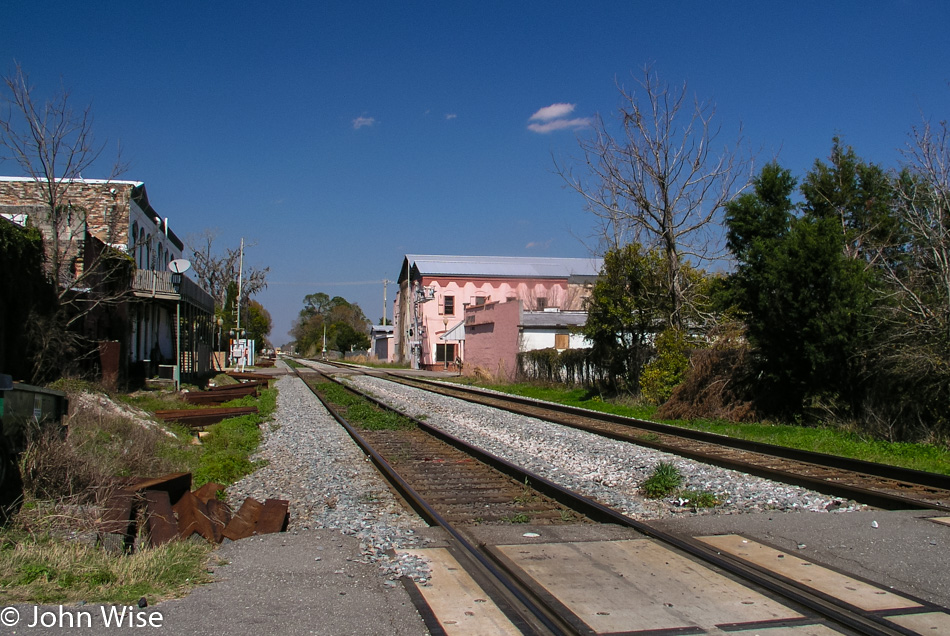
The back roads of Florida and America, in general, are only back roads to us city dwellers. These roads are not freeways; hence, they must be back roads, is what one would say. In reality, though, they are major thoroughfares connecting small towns to larger ones. Even smaller than these are the roads that cross communities, and then you finally reach the real back roads. These back roads are typically dirt, though quite often, you’ll find them paved. However, it can happen that these roads were last paved 50 or more years ago, and much of their edges are crumbling into the dirt.
So, although I call this trip a back road tour of the South, it is much more accurately described as getting as far off the freeway as possible while still maintaining all the creature comforts that support my traveling companions.
We are out far enough, though, that the character of the land comes shining through. On the freeways, much of America looks the same. The trees may be different, the hills might roll higher or lower, and fields of various crops can line the road, but the generic franchised icons of civilization repeat over and over again as though America’s four million miles of roads were one long homogeneous continuity of the same gas stations, fast food restaurants, hotels, and various other services.
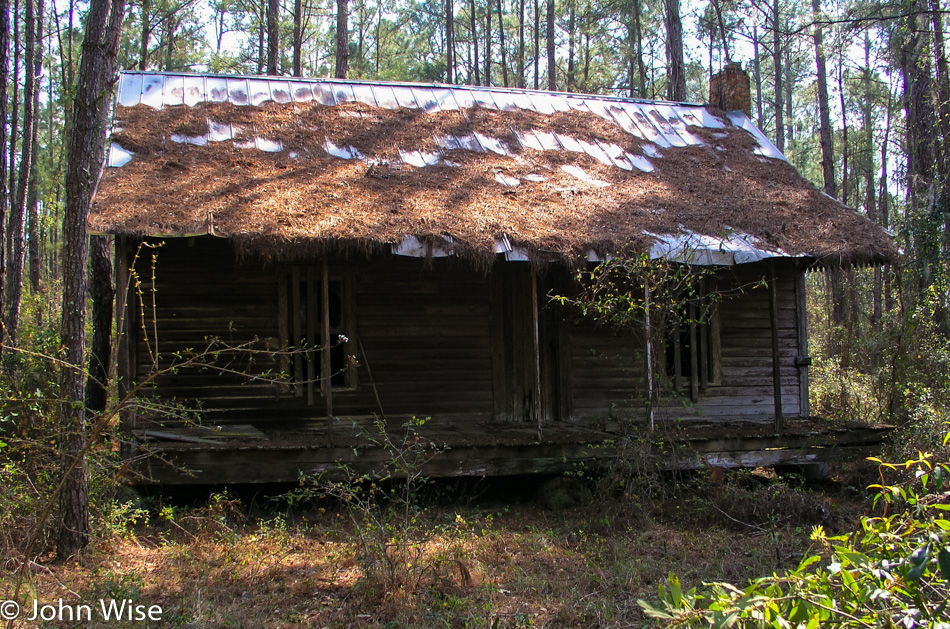
Out on the back roads you have the chance to randomly stop here or there. You can look at the things that lend character to a place. Check out a dilapidated cabin that might be the fifth one of these you have seen, but each will have an absolute uniqueness to it. Rail bridges, small streams, and driving along tree-lined roads all share a beauty and intimacy out here that it doesn’t matter if you have seen one or a hundred; their shape, color, height, smell, and other characteristics are all different.
It is the back roads where you find great boiled peanuts and rusting relics of an age that has been left behind. Generally, the pace is slower out here, but you still will find the impatient fool on your bumper as you move like a sloth crawling along particularly scenic stretches of road. The longer I am out here, the more enamored I find myself with the characters, landscape, and ruin.
Give me a broken-down hotel sign that hasn’t attracted a patron in decades to a McDonald’s any day of the week. There are still waters reflecting trees, flowers, sky, and grasses. Roadside attractions don’t have to be the world’s largest ball of twine; I find the chipped paint next to a rusting door handle to hold stories of the last occupants, while even a burned roadside tells you of those less careless and appreciative of what the world around them is to those like me.
I drive these American roads in search of our country. I look for markers from our past so I might glimpse our future, which is very much like the cycle of life: a place is born, and it dies, either from neglect, abandonment, or decrepitude. Our natural world and its biotas recede from the weight of man’s heavy hand; my journey into its domain allows me to witness what increasingly feels to be a rare sight.
Through it all, I love our country even more. The more you can appreciate all the elements, from the anthills, moss, broken windows, fences needing mending, lonely farm animals in the rain, to thistles, thorns, bugs, roadkill skunks, early closing hours, toothless merchants, and even a policeman hiding around the corner, the more you arrive at a near-constant state of wonderment.
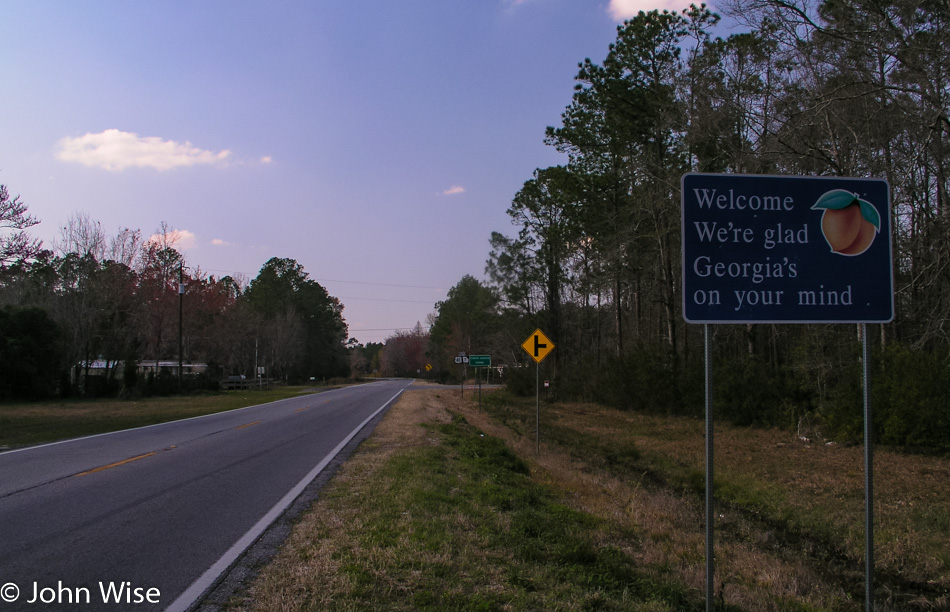
Florida gives way to Georgia late in the afternoon. Our trek across Georgia will be a short one, with our destination being Alabama. The first town we pass through is Valdosta, as opposed to the three small communities we passed on road number 41. Places with a few homes, a lot of farms, and maybe an equipment shop are hard to call towns; they are more like communities in my eyes.
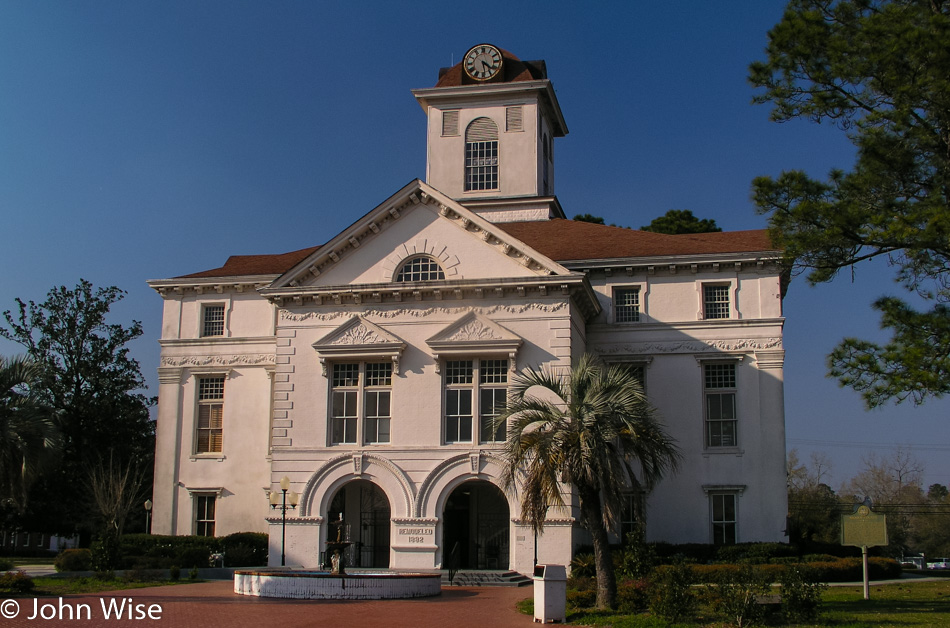
Valdosta is one of those small towns you wished someone had told you about earlier in life. It is one of the places you add to your list of returns, such as North Hero, Vermont, Apalachicola, Florida, Monterey, California, Ruidoso, or New Mexico. All too frequently, cities across America have given away any hope for maintaining their historical integrity. The old is bulldozed for the new, and soon, a clone city with Circuit City, Office Max, Red Lobster, Walmart, and Dollar Stores has taken over.
In Valdosta, at least from the view offered to these travelers entering the city from the south, this place packs in the small-town charm. Main Street is vibrant, with as much traffic as there are stores open, and it appears that all the shops have tenants. Awnings hang over sidewalks that have park benches for resting your feet before making your way through this shopping district. The alleys are as clean as the sidewalks; this place couldn’t be more inviting.
We are just passing through. Auntie and Grandpa are sightseeing; I’m scouting a future road trip for Caroline and me. On the way out of town, we pass a Carnegie Library, the first I have consciously seen, although I’m certain I must have passed hundreds over the years. Not much further down the road, and we enter Quitman.
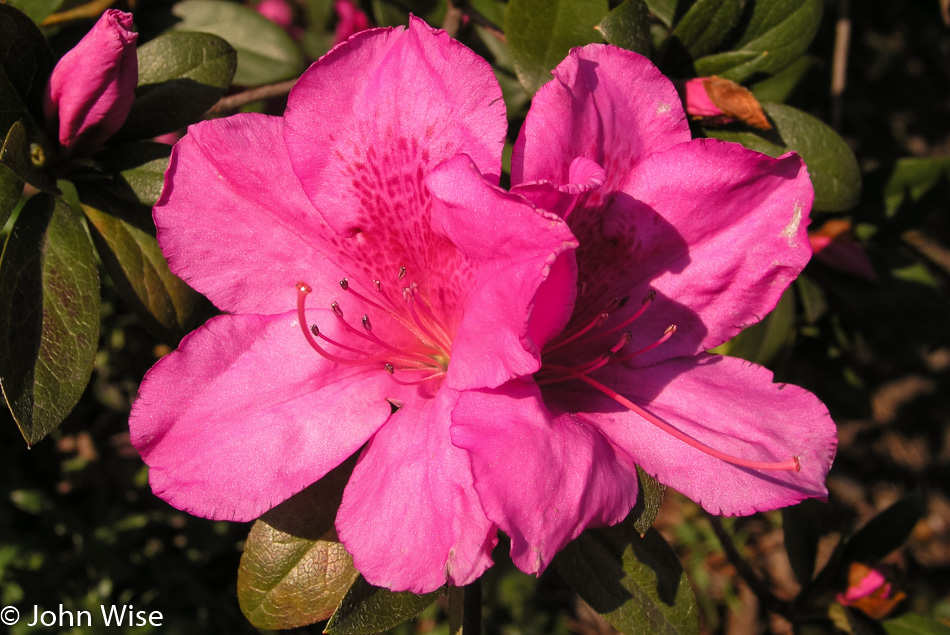
This is becoming a trend, Georgia is a downright all-around beautiful state with gorgeous cities. Brunswick, in the southeast, was the first city in Georgia that Caroline and I visited a couple of years ago, quickly followed by Savannah, both of which we were enamored with, while today it is Valdosta and Quitman.
Again, Main Street sets the tempo with two-story brick-built structures lining a divided road marking the downtown area. On either end of the main street are the churches; Baptist, Methodist, and Episcopal are the dominant beliefs. Branching off of downtown are southern-style and Victorian-style homes that these small communities have so far been able to maintain.
Well-kept yards, multi-colored azaleas, Spanish-moss-draped trees lining small streets, a gazebo, and a local cemetery give the eyes and senses plenty to take in as you begin to realize you are falling in love and start to wonder how you could move into a town like this?
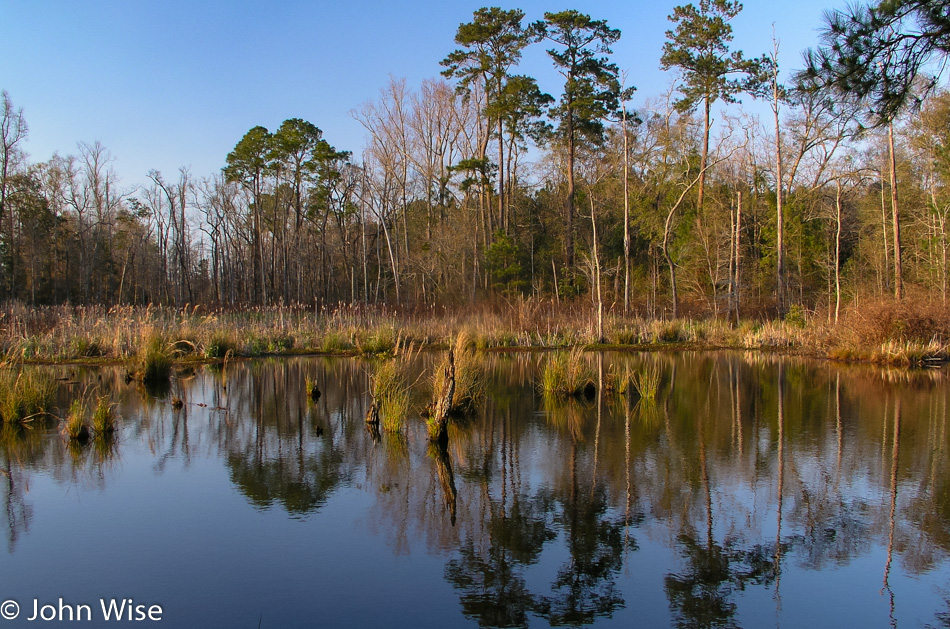
Whigham down the road, on the other hand, shows you firsthand how most of these small towns cannot hold on. The shops are closed, boarded up, broken into, falling apart, and falling down. The homes are no longer well kept, and age will take its toll to ensure that without revitalization, the town will someday become but a memory.
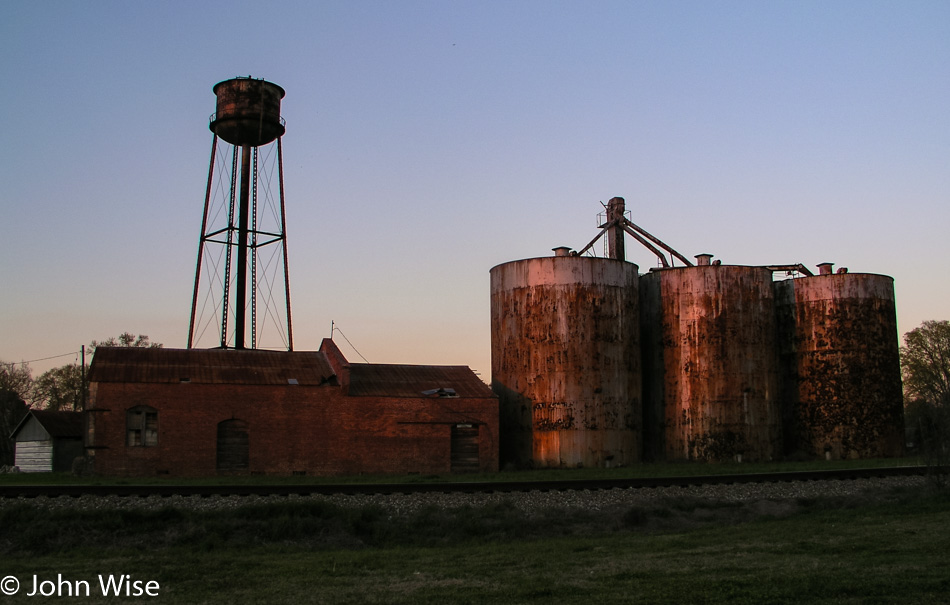
Before crossing into Alabama, we pass through Donalsonville. This town is in the middle of becoming a has-been and reflects what Quitman worked to save. The shops, for the most part, are still open. They are rough around the edges, wear and tear, and the passing of years are hurting the charm they once held. The main road skirts the old town so many a visitor will never see this little corner, further depressing its chances of rediscovering its glory days. Tourism amongst these types of small towns would be a lifesaver, but little to no money exists to help rescue them. So, these towns will gradually disappear, and we all lose a great part of America because of it.
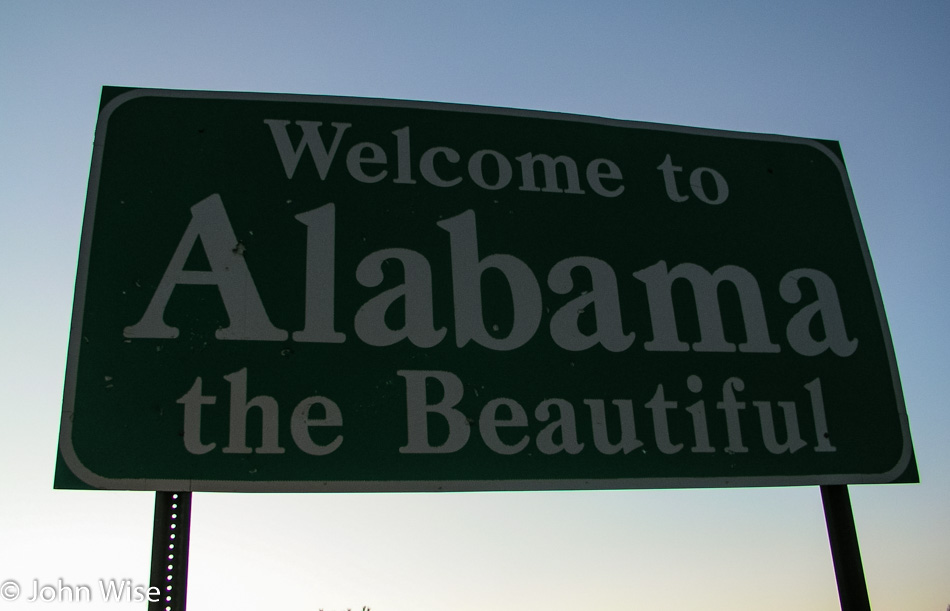
It’s near dark crossing the border, and not a long drive to the hotel. It is apparent that Dothan is a larger city than the three of us had imagined. Caroline helped guide us to our lodging via long-distance help.
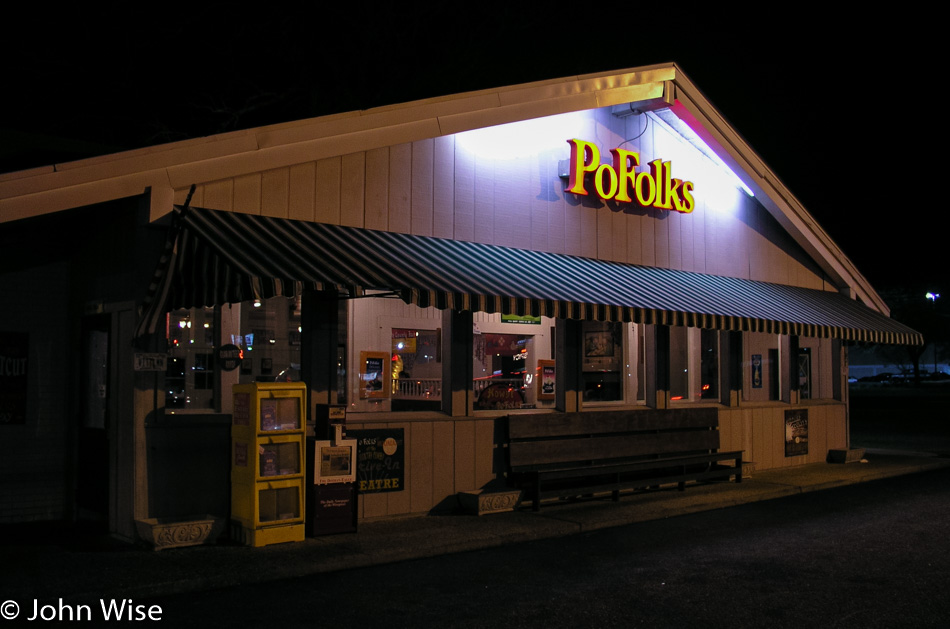
Seeing the hotel, I spot a billboard for Pofolk’s, which, while still active here in the south, has disappeared out west. Grandpa and I make the short drive around the corner to sit down for some dinner and pick up Auntie something to go as she stayed in the room.
